

How to Write an Essay
Use the links below to jump directly to any section of this guide:
Essay Writing Fundamentals
How to prepare to write an essay, how to edit an essay, how to share and publish your essays, how to get essay writing help, how to find essay writing inspiration, resources for teaching essay writing.
Essays, short prose compositions on a particular theme or topic, are the bread and butter of academic life. You write them in class, for homework, and on standardized tests to show what you know. Unlike other kinds of academic writing (like the research paper) and creative writing (like short stories and poems), essays allow you to develop your original thoughts on a prompt or question. Essays come in many varieties: they can be expository (fleshing out an idea or claim), descriptive, (explaining a person, place, or thing), narrative (relating a personal experience), or persuasive (attempting to win over a reader). This guide is a collection of dozens of links about academic essay writing that we have researched, categorized, and annotated in order to help you improve your essay writing.
Essays are different from other forms of writing; in turn, there are different kinds of essays. This section contains general resources for getting to know the essay and its variants. These resources introduce and define the essay as a genre, and will teach you what to expect from essay-based assessments.
Purdue OWL Online Writing Lab
One of the most trusted academic writing sites, Purdue OWL provides a concise introduction to the four most common types of academic essays.
"The Essay: History and Definition" (ThoughtCo)
This snappy article from ThoughtCo talks about the origins of the essay and different kinds of essays you might be asked to write.
"What Is An Essay?" Video Lecture (Coursera)
The University of California at Irvine's free video lecture, available on Coursera, tells you everything you need to know about the essay.
Wikipedia Article on the "Essay"
Wikipedia's article on the essay is comprehensive, providing both English-language and global perspectives on the essay form. Learn about the essay's history, forms, and styles.
"Understanding College and Academic Writing" (Aims Online Writing Lab)
This list of common academic writing assignments (including types of essay prompts) will help you know what to expect from essay-based assessments.
Before you start writing your essay, you need to figure out who you're writing for (audience), what you're writing about (topic/theme), and what you're going to say (argument and thesis). This section contains links to handouts, chapters, videos and more to help you prepare to write an essay.
How to Identify Your Audience
"Audience" (Univ. of North Carolina Writing Center)
This handout provides questions you can ask yourself to determine the audience for an academic writing assignment. It also suggests strategies for fitting your paper to your intended audience.
"Purpose, Audience, Tone, and Content" (Univ. of Minnesota Libraries)
This extensive book chapter from Writing for Success , available online through Minnesota Libraries Publishing, is followed by exercises to try out your new pre-writing skills.
"Determining Audience" (Aims Online Writing Lab)
This guide from a community college's writing center shows you how to know your audience, and how to incorporate that knowledge in your thesis statement.
"Know Your Audience" ( Paper Rater Blog)
This short blog post uses examples to show how implied audiences for essays differ. It reminds you to think of your instructor as an observer, who will know only the information you pass along.
How to Choose a Theme or Topic
"Research Tutorial: Developing Your Topic" (YouTube)
Take a look at this short video tutorial from the University of North Carolina at Chapel Hill to understand the basics of developing a writing topic.
"How to Choose a Paper Topic" (WikiHow)
This simple, step-by-step guide (with pictures!) walks you through choosing a paper topic. It starts with a detailed description of brainstorming and ends with strategies to refine your broad topic.
"How to Read an Assignment: Moving From Assignment to Topic" (Harvard College Writing Center)
Did your teacher give you a prompt or other instructions? This guide helps you understand the relationship between an essay assignment and your essay's topic.
"Guidelines for Choosing a Topic" (CliffsNotes)
This study guide from CliffsNotes both discusses how to choose a topic and makes a useful distinction between "topic" and "thesis."
How to Come Up with an Argument
"Argument" (Univ. of North Carolina Writing Center)
Not sure what "argument" means in the context of academic writing? This page from the University of North Carolina is a good place to start.
"The Essay Guide: Finding an Argument" (Study Hub)
This handout explains why it's important to have an argument when beginning your essay, and provides tools to help you choose a viable argument.
"Writing a Thesis and Making an Argument" (University of Iowa)
This page from the University of Iowa's Writing Center contains exercises through which you can develop and refine your argument and thesis statement.
"Developing a Thesis" (Harvard College Writing Center)
This page from Harvard's Writing Center collates some helpful dos and don'ts of argumentative writing, from steps in constructing a thesis to avoiding vague and confrontational thesis statements.
"Suggestions for Developing Argumentative Essays" (Berkeley Student Learning Center)
This page offers concrete suggestions for each stage of the essay writing process, from topic selection to drafting and editing.
How to Outline your Essay
"Outlines" (Univ. of North Carolina at Chapel Hill via YouTube)
This short video tutorial from the University of North Carolina at Chapel Hill shows how to group your ideas into paragraphs or sections to begin the outlining process.
"Essay Outline" (Univ. of Washington Tacoma)
This two-page handout by a university professor simply defines the parts of an essay and then organizes them into an example outline.
"Types of Outlines and Samples" (Purdue OWL Online Writing Lab)
Purdue OWL gives examples of diverse outline strategies on this page, including the alphanumeric, full sentence, and decimal styles.
"Outlining" (Harvard College Writing Center)
Once you have an argument, according to this handout, there are only three steps in the outline process: generalizing, ordering, and putting it all together. Then you're ready to write!
"Writing Essays" (Plymouth Univ.)
This packet, part of Plymouth University's Learning Development series, contains descriptions and diagrams relating to the outlining process.
"How to Write A Good Argumentative Essay: Logical Structure" (Criticalthinkingtutorials.com via YouTube)
This longer video tutorial gives an overview of how to structure your essay in order to support your argument or thesis. It is part of a longer course on academic writing hosted on Udemy.
Now that you've chosen and refined your topic and created an outline, use these resources to complete the writing process. Most essays contain introductions (which articulate your thesis statement), body paragraphs, and conclusions. Transitions facilitate the flow from one paragraph to the next so that support for your thesis builds throughout the essay. Sources and citations show where you got the evidence to support your thesis, which ensures that you avoid plagiarism.
How to Write an Introduction
"Introductions" (Univ. of North Carolina Writing Center)
This page identifies the role of the introduction in any successful paper, suggests strategies for writing introductions, and warns against less effective introductions.
"How to Write A Good Introduction" (Michigan State Writing Center)
Beginning with the most common missteps in writing introductions, this guide condenses the essentials of introduction composition into seven points.
"The Introductory Paragraph" (ThoughtCo)
This blog post from academic advisor and college enrollment counselor Grace Fleming focuses on ways to grab your reader's attention at the beginning of your essay.
"Introductions and Conclusions" (Univ. of Toronto)
This guide from the University of Toronto gives advice that applies to writing both introductions and conclusions, including dos and don'ts.
"How to Write Better Essays: No One Does Introductions Properly" ( The Guardian )
This news article interviews UK professors on student essay writing; they point to introductions as the area that needs the most improvement.
How to Write a Thesis Statement
"Writing an Effective Thesis Statement" (YouTube)
This short, simple video tutorial from a college composition instructor at Tulsa Community College explains what a thesis statement is and what it does.
"Thesis Statement: Four Steps to a Great Essay" (YouTube)
This fantastic tutorial walks you through drafting a thesis, using an essay prompt on Nathaniel Hawthorne's The Scarlet Letter as an example.
"How to Write a Thesis Statement" (WikiHow)
This step-by-step guide (with pictures!) walks you through coming up with, writing, and editing a thesis statement. It invites you think of your statement as a "working thesis" that can change.
"How to Write a Thesis Statement" (Univ. of Indiana Bloomington)
Ask yourself the questions on this page, part of Indiana Bloomington's Writing Tutorial Services, when you're writing and refining your thesis statement.
"Writing Tips: Thesis Statements" (Univ. of Illinois Center for Writing Studies)
This page gives plentiful examples of good to great thesis statements, and offers questions to ask yourself when formulating a thesis statement.
How to Write Body Paragraphs
"Body Paragraph" (Brightstorm)
This module of a free online course introduces you to the components of a body paragraph. These include the topic sentence, information, evidence, and analysis.
"Strong Body Paragraphs" (Washington Univ.)
This handout from Washington's Writing and Research Center offers in-depth descriptions of the parts of a successful body paragraph.
"Guide to Paragraph Structure" (Deakin Univ.)
This handout is notable for color-coding example body paragraphs to help you identify the functions various sentences perform.
"Writing Body Paragraphs" (Univ. of Minnesota Libraries)
The exercises in this section of Writing for Success will help you practice writing good body paragraphs. It includes guidance on selecting primary support for your thesis.
"The Writing Process—Body Paragraphs" (Aims Online Writing Lab)
The information and exercises on this page will familiarize you with outlining and writing body paragraphs, and includes links to more information on topic sentences and transitions.
"The Five-Paragraph Essay" (ThoughtCo)
This blog post discusses body paragraphs in the context of one of the most common academic essay types in secondary schools.
How to Use Transitions
"Transitions" (Univ. of North Carolina Writing Center)
This page from the University of North Carolina at Chapel Hill explains what a transition is, and how to know if you need to improve your transitions.
"Using Transitions Effectively" (Washington Univ.)
This handout defines transitions, offers tips for using them, and contains a useful list of common transitional words and phrases grouped by function.
"Transitions" (Aims Online Writing Lab)
This page compares paragraphs without transitions to paragraphs with transitions, and in doing so shows how important these connective words and phrases are.
"Transitions in Academic Essays" (Scribbr)
This page lists four techniques that will help you make sure your reader follows your train of thought, including grouping similar information and using transition words.
"Transitions" (El Paso Community College)
This handout shows example transitions within paragraphs for context, and explains how transitions improve your essay's flow and voice.
"Make Your Paragraphs Flow to Improve Writing" (ThoughtCo)
This blog post, another from academic advisor and college enrollment counselor Grace Fleming, talks about transitions and other strategies to improve your essay's overall flow.
"Transition Words" (smartwords.org)
This handy word bank will help you find transition words when you're feeling stuck. It's grouped by the transition's function, whether that is to show agreement, opposition, condition, or consequence.
How to Write a Conclusion
"Parts of An Essay: Conclusions" (Brightstorm)
This module of a free online course explains how to conclude an academic essay. It suggests thinking about the "3Rs": return to hook, restate your thesis, and relate to the reader.
"Essay Conclusions" (Univ. of Maryland University College)
This overview of the academic essay conclusion contains helpful examples and links to further resources for writing good conclusions.
"How to End An Essay" (WikiHow)
This step-by-step guide (with pictures!) by an English Ph.D. walks you through writing a conclusion, from brainstorming to ending with a flourish.
"Ending the Essay: Conclusions" (Harvard College Writing Center)
This page collates useful strategies for writing an effective conclusion, and reminds you to "close the discussion without closing it off" to further conversation.
How to Include Sources and Citations
"Research and Citation Resources" (Purdue OWL Online Writing Lab)
Purdue OWL streamlines information about the three most common referencing styles (MLA, Chicago, and APA) and provides examples of how to cite different resources in each system.
EasyBib: Free Bibliography Generator
This online tool allows you to input information about your source and automatically generate citations in any style. Be sure to select your resource type before clicking the "cite it" button.
CitationMachine
Like EasyBib, this online tool allows you to input information about your source and automatically generate citations in any style.
Modern Language Association Handbook (MLA)
Here, you'll find the definitive and up-to-date record of MLA referencing rules. Order through the link above, or check to see if your library has a copy.
Chicago Manual of Style
Here, you'll find the definitive and up-to-date record of Chicago referencing rules. You can take a look at the table of contents, then choose to subscribe or start a free trial.
How to Avoid Plagiarism
"What is Plagiarism?" (plagiarism.org)
This nonprofit website contains numerous resources for identifying and avoiding plagiarism, and reminds you that even common activities like copying images from another website to your own site may constitute plagiarism.
"Plagiarism" (University of Oxford)
This interactive page from the University of Oxford helps you check for plagiarism in your work, making it clear how to avoid citing another person's work without full acknowledgement.
"Avoiding Plagiarism" (MIT Comparative Media Studies)
This quick guide explains what plagiarism is, what its consequences are, and how to avoid it. It starts by defining three words—quotation, paraphrase, and summary—that all constitute citation.
"Harvard Guide to Using Sources" (Harvard Extension School)
This comprehensive website from Harvard brings together articles, videos, and handouts about referencing, citation, and plagiarism.
Grammarly contains tons of helpful grammar and writing resources, including a free tool to automatically scan your essay to check for close affinities to published work.
Noplag is another popular online tool that automatically scans your essay to check for signs of plagiarism. Simply copy and paste your essay into the box and click "start checking."
Once you've written your essay, you'll want to edit (improve content), proofread (check for spelling and grammar mistakes), and finalize your work until you're ready to hand it in. This section brings together tips and resources for navigating the editing process.
"Writing a First Draft" (Academic Help)
This is an introduction to the drafting process from the site Academic Help, with tips for getting your ideas on paper before editing begins.
"Editing and Proofreading" (Univ. of North Carolina Writing Center)
This page provides general strategies for revising your writing. They've intentionally left seven errors in the handout, to give you practice in spotting them.
"How to Proofread Effectively" (ThoughtCo)
This article from ThoughtCo, along with those linked at the bottom, help describe common mistakes to check for when proofreading.
"7 Simple Edits That Make Your Writing 100% More Powerful" (SmartBlogger)
This blog post emphasizes the importance of powerful, concise language, and reminds you that even your personal writing heroes create clunky first drafts.
"Editing Tips for Effective Writing" (Univ. of Pennsylvania)
On this page from Penn's International Relations department, you'll find tips for effective prose, errors to watch out for, and reminders about formatting.
"Editing the Essay" (Harvard College Writing Center)
This article, the first of two parts, gives you applicable strategies for the editing process. It suggests reading your essay aloud, removing any jargon, and being unafraid to remove even "dazzling" sentences that don't belong.
"Guide to Editing and Proofreading" (Oxford Learning Institute)
This handout from Oxford covers the basics of editing and proofreading, and reminds you that neither task should be rushed.
In addition to plagiarism-checkers, Grammarly has a plug-in for your web browser that checks your writing for common mistakes.
After you've prepared, written, and edited your essay, you might want to share it outside the classroom. This section alerts you to print and web opportunities to share your essays with the wider world, from online writing communities and blogs to published journals geared toward young writers.
Sharing Your Essays Online
Go Teen Writers
Go Teen Writers is an online community for writers aged 13 - 19. It was founded by Stephanie Morrill, an author of contemporary young adult novels.
Tumblr is a blogging website where you can share your writing and interact with other writers online. It's easy to add photos, links, audio, and video components.
Writersky provides an online platform for publishing and reading other youth writers' work. Its current content is mostly devoted to fiction.
Publishing Your Essays Online
This teen literary journal publishes in print, on the web, and (more frequently), on a blog. It is committed to ensuring that "teens see their authentic experience reflected on its pages."
The Matador Review
This youth writing platform celebrates "alternative," unconventional writing. The link above will take you directly to the site's "submissions" page.
Teen Ink has a website, monthly newsprint magazine, and quarterly poetry magazine promoting the work of young writers.
The largest online reading platform, Wattpad enables you to publish your work and read others' work. Its inline commenting feature allows you to share thoughts as you read along.
Publishing Your Essays in Print
Canvas Teen Literary Journal
This quarterly literary magazine is published for young writers by young writers. They accept many kinds of writing, including essays.
The Claremont Review
This biannual international magazine, first published in 1992, publishes poetry, essays, and short stories from writers aged 13 - 19.
Skipping Stones
This young writers magazine, founded in 1988, celebrates themes relating to ecological and cultural diversity. It publishes poems, photos, articles, and stories.
The Telling Room
This nonprofit writing center based in Maine publishes children's work on their website and in book form. The link above directs you to the site's submissions page.
Essay Contests
Scholastic Arts and Writing Awards
This prestigious international writing contest for students in grades 7 - 12 has been committed to "supporting the future of creativity since 1923."
Society of Professional Journalists High School Essay Contest
An annual essay contest on the theme of journalism and media, the Society of Professional Journalists High School Essay Contest awards scholarships up to $1,000.
National YoungArts Foundation
Here, you'll find information on a government-sponsored writing competition for writers aged 15 - 18. The foundation welcomes submissions of creative nonfiction, novels, scripts, poetry, short story and spoken word.
Signet Classics Student Scholarship Essay Contest
With prompts on a different literary work each year, this competition from Signet Classics awards college scholarships up to $1,000.
"The Ultimate Guide to High School Essay Contests" (CollegeVine)
See this handy guide from CollegeVine for a list of more competitions you can enter with your academic essay, from the National Council of Teachers of English Achievement Awards to the National High School Essay Contest by the U.S. Institute of Peace.
Whether you're struggling to write academic essays or you think you're a pro, there are workshops and online tools that can help you become an even better writer. Even the most seasoned writers encounter writer's block, so be proactive and look through our curated list of resources to combat this common frustration.
Online Essay-writing Classes and Workshops
"Getting Started with Essay Writing" (Coursera)
Coursera offers lots of free, high-quality online classes taught by college professors. Here's one example, taught by instructors from the University of California Irvine.
"Writing and English" (Brightstorm)
Brightstorm's free video lectures are easy to navigate by topic. This unit on the parts of an essay features content on the essay hook, thesis, supporting evidence, and more.
"How to Write an Essay" (EdX)
EdX is another open online university course website with several two- to five-week courses on the essay. This one is geared toward English language learners.
Writer's Digest University
This renowned writers' website offers online workshops and interactive tutorials. The courses offered cover everything from how to get started through how to get published.
Writing.com
Signing up for this online writer's community gives you access to helpful resources as well as an international community of writers.
How to Overcome Writer's Block
"Symptoms and Cures for Writer's Block" (Purdue OWL)
Purdue OWL offers a list of signs you might have writer's block, along with ways to overcome it. Consider trying out some "invention strategies" or ways to curb writing anxiety.
"Overcoming Writer's Block: Three Tips" ( The Guardian )
These tips, geared toward academic writing specifically, are practical and effective. The authors advocate setting realistic goals, creating dedicated writing time, and participating in social writing.
"Writing Tips: Strategies for Overcoming Writer's Block" (Univ. of Illinois)
This page from the University of Illinois at Urbana-Champaign's Center for Writing Studies acquaints you with strategies that do and do not work to overcome writer's block.
"Writer's Block" (Univ. of Toronto)
Ask yourself the questions on this page; if the answer is "yes," try out some of the article's strategies. Each question is accompanied by at least two possible solutions.
If you have essays to write but are short on ideas, this section's links to prompts, example student essays, and celebrated essays by professional writers might help. You'll find writing prompts from a variety of sources, student essays to inspire you, and a number of essay writing collections.
Essay Writing Prompts
"50 Argumentative Essay Topics" (ThoughtCo)
Take a look at this list and the others ThoughtCo has curated for different kinds of essays. As the author notes, "a number of these topics are controversial and that's the point."
"401 Prompts for Argumentative Writing" ( New York Times )
This list (and the linked lists to persuasive and narrative writing prompts), besides being impressive in length, is put together by actual high school English teachers.
"SAT Sample Essay Prompts" (College Board)
If you're a student in the U.S., your classroom essay prompts are likely modeled on the prompts in U.S. college entrance exams. Take a look at these official examples from the SAT.
"Popular College Application Essay Topics" (Princeton Review)
This page from the Princeton Review dissects recent Common Application essay topics and discusses strategies for answering them.
Example Student Essays
"501 Writing Prompts" (DePaul Univ.)
This nearly 200-page packet, compiled by the LearningExpress Skill Builder in Focus Writing Team, is stuffed with writing prompts, example essays, and commentary.
"Topics in English" (Kibin)
Kibin is a for-pay essay help website, but its example essays (organized by topic) are available for free. You'll find essays on everything from A Christmas Carol to perseverance.
"Student Writing Models" (Thoughtful Learning)
Thoughtful Learning, a website that offers a variety of teaching materials, provides sample student essays on various topics and organizes them by grade level.
"Five-Paragraph Essay" (ThoughtCo)
In this blog post by a former professor of English and rhetoric, ThoughtCo brings together examples of five-paragraph essays and commentary on the form.
The Best Essay Writing Collections
The Best American Essays of the Century by Joyce Carol Oates (Amazon)
This collection of American essays spanning the twentieth century was compiled by award winning author and Princeton professor Joyce Carol Oates.
The Best American Essays 2017 by Leslie Jamison (Amazon)
Leslie Jamison, the celebrated author of essay collection The Empathy Exams , collects recent, high-profile essays into a single volume.
The Art of the Personal Essay by Phillip Lopate (Amazon)
Documentary writer Phillip Lopate curates this historical overview of the personal essay's development, from the classical era to the present.
The White Album by Joan Didion (Amazon)
This seminal essay collection was authored by one of the most acclaimed personal essayists of all time, American journalist Joan Didion.
Consider the Lobster by David Foster Wallace (Amazon)
Read this famous essay collection by David Foster Wallace, who is known for his experimentation with the essay form. He pushed the boundaries of personal essay, reportage, and political polemic.
"50 Successful Harvard Application Essays" (Staff of the The Harvard Crimson )
If you're looking for examples of exceptional college application essays, this volume from Harvard's daily student newspaper is one of the best collections on the market.
Are you an instructor looking for the best resources for teaching essay writing? This section contains resources for developing in-class activities and student homework assignments. You'll find content from both well-known university writing centers and online writing labs.
Essay Writing Classroom Activities for Students
"In-class Writing Exercises" (Univ. of North Carolina Writing Center)
This page lists exercises related to brainstorming, organizing, drafting, and revising. It also contains suggestions for how to implement the suggested exercises.
"Teaching with Writing" (Univ. of Minnesota Center for Writing)
Instructions and encouragement for using "freewriting," one-minute papers, logbooks, and other write-to-learn activities in the classroom can be found here.
"Writing Worksheets" (Berkeley Student Learning Center)
Berkeley offers this bank of writing worksheets to use in class. They are nested under headings for "Prewriting," "Revision," "Research Papers" and more.
"Using Sources and Avoiding Plagiarism" (DePaul University)
Use these activities and worksheets from DePaul's Teaching Commons when instructing students on proper academic citation practices.
Essay Writing Homework Activities for Students
"Grammar and Punctuation Exercises" (Aims Online Writing Lab)
These five interactive online activities allow students to practice editing and proofreading. They'll hone their skills in correcting comma splices and run-ons, identifying fragments, using correct pronoun agreement, and comma usage.
"Student Interactives" (Read Write Think)
Read Write Think hosts interactive tools, games, and videos for developing writing skills. They can practice organizing and summarizing, writing poetry, and developing lines of inquiry and analysis.
This free website offers writing and grammar activities for all grade levels. The lessons are designed to be used both for large classes and smaller groups.
"Writing Activities and Lessons for Every Grade" (Education World)
Education World's page on writing activities and lessons links you to more free, online resources for learning how to "W.R.I.T.E.": write, revise, inform, think, and edit.
- PDFs for all 136 Lit Terms we cover
- Downloads of 1929 LitCharts Lit Guides
- Teacher Editions for every Lit Guide
- Explanations and citation info for 40,694 quotes across 1929 books
- Downloadable (PDF) line-by-line translations of every Shakespeare play
Need something? Request a new guide .
How can we improve? Share feedback .
LitCharts is hiring!

Ultimate Guide to Writing Your College Essay
Tips for writing an effective college essay.
College admissions essays are an important part of your college application and gives you the chance to show colleges and universities your character and experiences. This guide will give you tips to write an effective college essay.
Want free help with your college essay?
UPchieve connects you with knowledgeable and friendly college advisors—online, 24/7, and completely free. Get 1:1 help brainstorming topics, outlining your essay, revising a draft, or editing grammar.
Writing a strong college admissions essay
Learn about the elements of a solid admissions essay.
Avoiding common admissions essay mistakes
Learn some of the most common mistakes made on college essays
Brainstorming tips for your college essay
Stuck on what to write your college essay about? Here are some exercises to help you get started.
How formal should the tone of your college essay be?
Learn how formal your college essay should be and get tips on how to bring out your natural voice.
Taking your college essay to the next level
Hear an admissions expert discuss the appropriate level of depth necessary in your college essay.
Student Stories
Student Story: Admissions essay about a formative experience
Get the perspective of a current college student on how he approached the admissions essay.
Student Story: Admissions essay about personal identity
Get the perspective of a current college student on how she approached the admissions essay.
Student Story: Admissions essay about community impact
Student story: admissions essay about a past mistake, how to write a college application essay, tips for writing an effective application essay, sample college essay 1 with feedback, sample college essay 2 with feedback.
This content is licensed by Khan Academy and is available for free at www.khanacademy.org.

Essay Writing: A complete guide for students and teachers
P LANNING, PARAGRAPHING AND POLISHING: FINE-TUNING THE PERFECT ESSAY
Essay writing is an essential skill for every student. Whether writing a particular academic essay (such as persuasive, narrative, descriptive, or expository) or a timed exam essay, the key to getting good at writing is to write. Creating opportunities for our students to engage in extended writing activities will go a long way to helping them improve their skills as scribes.
But, putting the hours in alone will not be enough to attain the highest levels in essay writing. Practice must be meaningful. Once students have a broad overview of how to structure the various types of essays, they are ready to narrow in on the minor details that will enable them to fine-tune their work as a lean vehicle of their thoughts and ideas.

In this article, we will drill down to some aspects that will assist students in taking their essay writing skills up a notch. Many ideas and activities can be integrated into broader lesson plans based on essay writing. Often, though, they will work effectively in isolation – just as athletes isolate physical movements to drill that are relevant to their sport. When these movements become second nature, they can be repeated naturally in the context of the game or in our case, the writing of the essay.
THE ULTIMATE NONFICTION WRITING TEACHING RESOURCE

- 270 pages of the most effective teaching strategies
- 50+ digital tools ready right out of the box
- 75 editable resources for student differentiation
- Loads of tricks and tips to add to your teaching tool bag
- All explanations are reinforced with concrete examples.
- Links to high-quality video tutorials
- Clear objectives easy to match to the demands of your curriculum
Planning an essay

The Boys Scouts’ motto is famously ‘Be Prepared’. It’s a solid motto that can be applied to most aspects of life; essay writing is no different. Given the purpose of an essay is generally to present a logical and reasoned argument, investing time in organising arguments, ideas, and structure would seem to be time well spent.
Given that essays can take a wide range of forms and that we all have our own individual approaches to writing, it stands to reason that there will be no single best approach to the planning stage of essay writing. That said, there are several helpful hints and techniques we can share with our students to help them wrestle their ideas into a writable form. Let’s take a look at a few of the best of these:
BREAK THE QUESTION DOWN: UNDERSTAND YOUR ESSAY TOPIC.
Whether students are tackling an assignment that you have set for them in class or responding to an essay prompt in an exam situation, they should get into the habit of analyzing the nature of the task. To do this, they should unravel the question’s meaning or prompt. Students can practice this in class by responding to various essay titles, questions, and prompts, thereby gaining valuable experience breaking these down.
Have students work in groups to underline and dissect the keywords and phrases and discuss what exactly is being asked of them in the task. Are they being asked to discuss, describe, persuade, or explain? Understanding the exact nature of the task is crucial before going any further in the planning process, never mind the writing process .
BRAINSTORM AND MIND MAP WHAT YOU KNOW:
Once students have understood what the essay task asks them, they should consider what they know about the topic and, often, how they feel about it. When teaching essay writing, we so often emphasize that it is about expressing our opinions on things, but for our younger students what they think about something isn’t always obvious, even to themselves.
Brainstorming and mind-mapping what they know about a topic offers them an opportunity to uncover not just what they already know about a topic, but also gives them a chance to reveal to themselves what they think about the topic. This will help guide them in structuring their research and, later, the essay they will write . When writing an essay in an exam context, this may be the only ‘research’ the student can undertake before the writing, so practicing this will be even more important.
RESEARCH YOUR ESSAY
The previous step above should reveal to students the general direction their research will take. With the ubiquitousness of the internet, gone are the days of students relying on a single well-thumbed encyclopaedia from the school library as their sole authoritative source in their essay. If anything, the real problem for our students today is narrowing down their sources to a manageable number. Students should use the information from the previous step to help here. At this stage, it is important that they:
● Ensure the research material is directly relevant to the essay task
● Record in detail the sources of the information that they will use in their essay
● Engage with the material personally by asking questions and challenging their own biases
● Identify the key points that will be made in their essay
● Group ideas, counterarguments, and opinions together
● Identify the overarching argument they will make in their own essay.
Once these stages have been completed the student is ready to organise their points into a logical order.
WRITING YOUR ESSAY
There are a number of ways for students to organize their points in preparation for writing. They can use graphic organizers , post-it notes, or any number of available writing apps. The important thing for them to consider here is that their points should follow a logical progression. This progression of their argument will be expressed in the form of body paragraphs that will inform the structure of their finished essay.
The number of paragraphs contained in an essay will depend on a number of factors such as word limits, time limits, the complexity of the question etc. Regardless of the essay’s length, students should ensure their essay follows the Rule of Three in that every essay they write contains an introduction, body paragraphs, and a conclusion.
Generally speaking, essay paragraphs will focus on one main idea that is usually expressed in a topic sentence that is followed by a series of supporting sentences that bolster that main idea. The first and final sentences are of the most significance here with the first sentence of a paragraph making the point to the reader and the final sentence of the paragraph making the overall relevance to the essay’s argument crystal clear.
Though students will most likely be familiar with the broad generic structure of essays, it is worth investing time to ensure they have a clear conception of how each part of the essay works, that is, of the exact nature of the task it performs. Let’s review:
Common Essay Structure
Introduction: Provides the reader with context for the essay. It states the broad argument that the essay will make and informs the reader of the writer’s general perspective and approach to the question.
Body Paragraphs: These are the ‘meat’ of the essay and lay out the argument stated in the introduction point by point with supporting evidence.
Conclusion: Usually, the conclusion will restate the central argument while summarising the essay’s main supporting reasons before linking everything back to the original question.
ESSAY WRITING PARAGRAPH WRITING TIPS

● Each paragraph should focus on a single main idea
● Paragraphs should follow a logical sequence; students should group similar ideas together to avoid incoherence
● Paragraphs should be denoted consistently; students should choose either to indent or skip a line
● Transition words and phrases such as alternatively , consequently , in contrast should be used to give flow and provide a bridge between paragraphs.
HOW TO EDIT AN ESSAY

Students shouldn’t expect their essays to emerge from the writing process perfectly formed. Except in exam situations and the like, thorough editing is an essential aspect in the writing process.
Often, students struggle with this aspect of the process the most. After spending hours of effort on planning, research, and writing the first draft, students can be reluctant to go back over the same terrain they have so recently travelled. It is important at this point to give them some helpful guidelines to help them to know what to look out for. The following tips will provide just such help:
One Piece at a Time: There is a lot to look out for in the editing process and often students overlook aspects as they try to juggle too many balls during the process. One effective strategy to combat this is for students to perform a number of rounds of editing with each focusing on a different aspect. For example, the first round could focus on content, the second round on looking out for word repetition (use a thesaurus to help here), with the third attending to spelling and grammar.
Sum It Up: When reviewing the paragraphs they have written, a good starting point is for students to read each paragraph and attempt to sum up its main point in a single line. If this is not possible, their readers will most likely have difficulty following their train of thought too and the paragraph needs to be overhauled.
Let It Breathe: When possible, encourage students to allow some time for their essay to ‘breathe’ before returning to it for editing purposes. This may require some skilful time management on the part of the student, for example, a student rush-writing the night before the deadline does not lend itself to effective editing. Fresh eyes are one of the sharpest tools in the writer’s toolbox.
Read It Aloud: This time-tested editing method is a great way for students to identify mistakes and typos in their work. We tend to read things more slowly when reading aloud giving us the time to spot errors. Also, when we read silently our minds can often fill in the gaps or gloss over the mistakes that will become apparent when we read out loud.
Phone a Friend: Peer editing is another great way to identify errors that our brains may miss when reading our own work. Encourage students to partner up for a little ‘you scratch my back, I scratch yours’.
Use Tech Tools: We need to ensure our students have the mental tools to edit their own work and for this they will need a good grasp of English grammar and punctuation. However, there are also a wealth of tech tools such as spellcheck and grammar checks that can offer a great once-over option to catch anything students may have missed in earlier editing rounds.

Putting the Jewels on Display: While some struggle to edit, others struggle to let go. There comes a point when it is time for students to release their work to the reader. They must learn to relinquish control after the creation is complete. This will be much easier to achieve if the student feels that they have done everything in their control to ensure their essay is representative of the best of their abilities and if they have followed the advice here, they should be confident they have done so.
WRITING CHECKLISTS FOR ALL TEXT TYPES

⭐⭐⭐⭐⭐ (92 Reviews)
ESSAY WRITING video tutorials


Get science-backed answers as you write with Paperpal's Research feature
How to Write an Essay Introduction (with Examples)

The introduction of an essay plays a critical role in engaging the reader and providing contextual information about the topic. It sets the stage for the rest of the essay, establishes the tone and style, and motivates the reader to continue reading.
Table of Contents
What is an essay introduction , what to include in an essay introduction, how to create an essay structure , step-by-step process for writing an essay introduction , how to write an introduction paragraph , how to write a hook for your essay , how to include background information , how to write a thesis statement .
- Argumentative Essay Introduction Example:
- Expository Essay Introduction Example
Literary Analysis Essay Introduction Example
Check and revise – checklist for essay introduction , key takeaways , frequently asked questions .
An introduction is the opening section of an essay, paper, or other written work. It introduces the topic and provides background information, context, and an overview of what the reader can expect from the rest of the work. 1 The key is to be concise and to the point, providing enough information to engage the reader without delving into excessive detail.
The essay introduction is crucial as it sets the tone for the entire piece and provides the reader with a roadmap of what to expect. Here are key elements to include in your essay introduction:
- Hook : Start with an attention-grabbing statement or question to engage the reader. This could be a surprising fact, a relevant quote, or a compelling anecdote.
- Background information : Provide context and background information to help the reader understand the topic. This can include historical information, definitions of key terms, or an overview of the current state of affairs related to your topic.
- Thesis statement : Clearly state your main argument or position on the topic. Your thesis should be concise and specific, providing a clear direction for your essay.
Before we get into how to write an essay introduction, we need to know how it is structured. The structure of an essay is crucial for organizing your thoughts and presenting them clearly and logically. It is divided as follows: 2
- Introduction: The introduction should grab the reader’s attention with a hook, provide context, and include a thesis statement that presents the main argument or purpose of the essay.
- Body: The body should consist of focused paragraphs that support your thesis statement using evidence and analysis. Each paragraph should concentrate on a single central idea or argument and provide evidence, examples, or analysis to back it up.
- Conclusion: The conclusion should summarize the main points and restate the thesis differently. End with a final statement that leaves a lasting impression on the reader. Avoid new information or arguments.

Here’s a step-by-step guide on how to write an essay introduction:
- Start with a Hook : Begin your introduction paragraph with an attention-grabbing statement, question, quote, or anecdote related to your topic. The hook should pique the reader’s interest and encourage them to continue reading.
- Provide Background Information : This helps the reader understand the relevance and importance of the topic.
- State Your Thesis Statement : The last sentence is the main argument or point of your essay. It should be clear, concise, and directly address the topic of your essay.
- Preview the Main Points : This gives the reader an idea of what to expect and how you will support your thesis.
- Keep it Concise and Clear : Avoid going into too much detail or including information not directly relevant to your topic.
- Revise : Revise your introduction after you’ve written the rest of your essay to ensure it aligns with your final argument.
Here’s an example of an essay introduction paragraph about the importance of education:
Education is often viewed as a fundamental human right and a key social and economic development driver. As Nelson Mandela once famously said, “Education is the most powerful weapon which you can use to change the world.” It is the key to unlocking a wide range of opportunities and benefits for individuals, societies, and nations. In today’s constantly evolving world, education has become even more critical. It has expanded beyond traditional classroom learning to include digital and remote learning, making education more accessible and convenient. This essay will delve into the importance of education in empowering individuals to achieve their dreams, improving societies by promoting social justice and equality, and driving economic growth by developing a skilled workforce and promoting innovation.
This introduction paragraph example includes a hook (the quote by Nelson Mandela), provides some background information on education, and states the thesis statement (the importance of education).
This is one of the key steps in how to write an essay introduction. Crafting a compelling hook is vital because it sets the tone for your entire essay and determines whether your readers will stay interested. A good hook draws the reader in and sets the stage for the rest of your essay.
- Avoid Dry Fact : Instead of simply stating a bland fact, try to make it engaging and relevant to your topic. For example, if you’re writing about the benefits of exercise, you could start with a startling statistic like, “Did you know that regular exercise can increase your lifespan by up to seven years?”
- Avoid Using a Dictionary Definition : While definitions can be informative, they’re not always the most captivating way to start an essay. Instead, try to use a quote, anecdote, or provocative question to pique the reader’s interest. For instance, if you’re writing about freedom, you could begin with a quote from a famous freedom fighter or philosopher.
- Do Not Just State a Fact That the Reader Already Knows : This ties back to the first point—your hook should surprise or intrigue the reader. For Here’s an introduction paragraph example, if you’re writing about climate change, you could start with a thought-provoking statement like, “Despite overwhelming evidence, many people still refuse to believe in the reality of climate change.”
Including background information in the introduction section of your essay is important to provide context and establish the relevance of your topic. When writing the background information, you can follow these steps:
- Start with a General Statement: Begin with a general statement about the topic and gradually narrow it down to your specific focus. For example, when discussing the impact of social media, you can begin by making a broad statement about social media and its widespread use in today’s society, as follows: “Social media has become an integral part of modern life, with billions of users worldwide.”
- Define Key Terms : Define any key terms or concepts that may be unfamiliar to your readers but are essential for understanding your argument.
- Provide Relevant Statistics: Use statistics or facts to highlight the significance of the issue you’re discussing. For instance, “According to a report by Statista, the number of social media users is expected to reach 4.41 billion by 2025.”
- Discuss the Evolution: Mention previous research or studies that have been conducted on the topic, especially those that are relevant to your argument. Mention key milestones or developments that have shaped its current impact. You can also outline some of the major effects of social media. For example, you can briefly describe how social media has evolved, including positives such as increased connectivity and issues like cyberbullying and privacy concerns.
- Transition to Your Thesis: Use the background information to lead into your thesis statement, which should clearly state the main argument or purpose of your essay. For example, “Given its pervasive influence, it is crucial to examine the impact of social media on mental health.”

A thesis statement is a concise summary of the main point or claim of an essay, research paper, or other type of academic writing. It appears near the end of the introduction. Here’s how to write a thesis statement:
- Identify the topic: Start by identifying the topic of your essay. For example, if your essay is about the importance of exercise for overall health, your topic is “exercise.”
- State your position: Next, state your position or claim about the topic. This is the main argument or point you want to make. For example, if you believe that regular exercise is crucial for maintaining good health, your position could be: “Regular exercise is essential for maintaining good health.”
- Support your position: Provide a brief overview of the reasons or evidence that support your position. These will be the main points of your essay. For example, if you’re writing an essay about the importance of exercise, you could mention the physical health benefits, mental health benefits, and the role of exercise in disease prevention.
- Make it specific: Ensure your thesis statement clearly states what you will discuss in your essay. For example, instead of saying, “Exercise is good for you,” you could say, “Regular exercise, including cardiovascular and strength training, can improve overall health and reduce the risk of chronic diseases.”
Examples of essay introduction
Here are examples of essay introductions for different types of essays:
Argumentative Essay Introduction Example:
Topic: Should the voting age be lowered to 16?
“The question of whether the voting age should be lowered to 16 has sparked nationwide debate. While some argue that 16-year-olds lack the requisite maturity and knowledge to make informed decisions, others argue that doing so would imbue young people with agency and give them a voice in shaping their future.”
Expository Essay Introduction Example
Topic: The benefits of regular exercise
“In today’s fast-paced world, the importance of regular exercise cannot be overstated. From improving physical health to boosting mental well-being, the benefits of exercise are numerous and far-reaching. This essay will examine the various advantages of regular exercise and provide tips on incorporating it into your daily routine.”
Text: “To Kill a Mockingbird” by Harper Lee
“Harper Lee’s novel, ‘To Kill a Mockingbird,’ is a timeless classic that explores themes of racism, injustice, and morality in the American South. Through the eyes of young Scout Finch, the reader is taken on a journey that challenges societal norms and forces characters to confront their prejudices. This essay will analyze the novel’s use of symbolism, character development, and narrative structure to uncover its deeper meaning and relevance to contemporary society.”
- Engaging and Relevant First Sentence : The opening sentence captures the reader’s attention and relates directly to the topic.
- Background Information : Enough background information is introduced to provide context for the thesis statement.
- Definition of Important Terms : Key terms or concepts that might be unfamiliar to the audience or are central to the argument are defined.
- Clear Thesis Statement : The thesis statement presents the main point or argument of the essay.
- Relevance to Main Body : Everything in the introduction directly relates to and sets up the discussion in the main body of the essay.

Writing a strong introduction is crucial for setting the tone and context of your essay. Here are the key takeaways for how to write essay introduction: 3
- Hook the Reader : Start with an engaging hook to grab the reader’s attention. This could be a compelling question, a surprising fact, a relevant quote, or an anecdote.
- Provide Background : Give a brief overview of the topic, setting the context and stage for the discussion.
- Thesis Statement : State your thesis, which is the main argument or point of your essay. It should be concise, clear, and specific.
- Preview the Structure : Outline the main points or arguments to help the reader understand the organization of your essay.
- Keep it Concise : Avoid including unnecessary details or information not directly related to your thesis.
- Revise and Edit : Revise your introduction to ensure clarity, coherence, and relevance. Check for grammar and spelling errors.
- Seek Feedback : Get feedback from peers or instructors to improve your introduction further.
The purpose of an essay introduction is to give an overview of the topic, context, and main ideas of the essay. It is meant to engage the reader, establish the tone for the rest of the essay, and introduce the thesis statement or central argument.
An essay introduction typically ranges from 5-10% of the total word count. For example, in a 1,000-word essay, the introduction would be roughly 50-100 words. However, the length can vary depending on the complexity of the topic and the overall length of the essay.
An essay introduction is critical in engaging the reader and providing contextual information about the topic. To ensure its effectiveness, consider incorporating these key elements: a compelling hook, background information, a clear thesis statement, an outline of the essay’s scope, a smooth transition to the body, and optional signposting sentences.
The process of writing an essay introduction is not necessarily straightforward, but there are several strategies that can be employed to achieve this end. When experiencing difficulty initiating the process, consider the following techniques: begin with an anecdote, a quotation, an image, a question, or a startling fact to pique the reader’s interest. It may also be helpful to consider the five W’s of journalism: who, what, when, where, why, and how. For instance, an anecdotal opening could be structured as follows: “As I ascended the stage, momentarily blinded by the intense lights, I could sense the weight of a hundred eyes upon me, anticipating my next move. The topic of discussion was climate change, a subject I was passionate about, and it was my first public speaking event. Little did I know , that pivotal moment would not only alter my perspective but also chart my life’s course.”
Crafting a compelling thesis statement for your introduction paragraph is crucial to grab your reader’s attention. To achieve this, avoid using overused phrases such as “In this paper, I will write about” or “I will focus on” as they lack originality. Instead, strive to engage your reader by substantiating your stance or proposition with a “so what” clause. While writing your thesis statement, aim to be precise, succinct, and clear in conveying your main argument.
To create an effective essay introduction, ensure it is clear, engaging, relevant, and contains a concise thesis statement. It should transition smoothly into the essay and be long enough to cover necessary points but not become overwhelming. Seek feedback from peers or instructors to assess its effectiveness.
References
- Cui, L. (2022). Unit 6 Essay Introduction. Building Academic Writing Skills .
- West, H., Malcolm, G., Keywood, S., & Hill, J. (2019). Writing a successful essay. Journal of Geography in Higher Education , 43 (4), 609-617.
- Beavers, M. E., Thoune, D. L., & McBeth, M. (2023). Bibliographic Essay: Reading, Researching, Teaching, and Writing with Hooks: A Queer Literacy Sponsorship. College English, 85(3), 230-242.
Paperpal is a comprehensive AI writing toolkit that helps students and researchers achieve 2x the writing in half the time. It leverages 21+ years of STM experience and insights from millions of research articles to provide in-depth academic writing, language editing, and submission readiness support to help you write better, faster.
Get accurate academic translations, rewriting support, grammar checks, vocabulary suggestions, and generative AI assistance that delivers human precision at machine speed. Try for free or upgrade to Paperpal Prime starting at US$19 a month to access premium features, including consistency, plagiarism, and 30+ submission readiness checks to help you succeed.
Experience the future of academic writing – Sign up to Paperpal and start writing for free!
Related Reads:
- What is an Argumentative Essay? How to Write It (With Examples)
- How to Paraphrase Research Papers Effectively
- How to Cite Social Media Sources in Academic Writing?
- How Long Should a Chapter Be?
Similarity Checks: The Author’s Guide to Plagiarism and Responsible Writing
Types of plagiarism and 6 tips to avoid it in your writing , you may also like, mla works cited page: format, template & examples, how to ace grant writing for research funding..., powerful academic phrases to improve your essay writing , how to write a high-quality conference paper, how paperpal’s research feature helps you develop and..., how paperpal is enhancing academic productivity and accelerating..., academic editing: how to self-edit academic text with..., 4 ways paperpal encourages responsible writing with ai, what are scholarly sources and where can you..., how to write a hypothesis types and examples .

Essay and dissertation writing skills
Planning your essay
Writing your introduction
Structuring your essay
- Writing essays in science subjects
- Brief video guides to support essay planning and writing
- Writing extended essays and dissertations
- Planning your dissertation writing time
Structuring your dissertation
- Top tips for writing longer pieces of work
Advice on planning and writing essays and dissertations
University essays differ from school essays in that they are less concerned with what you know and more concerned with how you construct an argument to answer the question. This means that the starting point for writing a strong essay is to first unpick the question and to then use this to plan your essay before you start putting pen to paper (or finger to keyboard).
A really good starting point for you are these short, downloadable Tips for Successful Essay Writing and Answering the Question resources. Both resources will help you to plan your essay, as well as giving you guidance on how to distinguish between different sorts of essay questions.
You may find it helpful to watch this seven-minute video on six tips for essay writing which outlines how to interpret essay questions, as well as giving advice on planning and structuring your writing:
Different disciplines will have different expectations for essay structure and you should always refer to your Faculty or Department student handbook or course Canvas site for more specific guidance.
However, broadly speaking, all essays share the following features:
Essays need an introduction to establish and focus the parameters of the discussion that will follow. You may find it helpful to divide the introduction into areas to demonstrate your breadth and engagement with the essay question. You might define specific terms in the introduction to show your engagement with the essay question; for example, ‘This is a large topic which has been variously discussed by many scientists and commentators. The principal tension is between the views of X and Y who define the main issues as…’ Breadth might be demonstrated by showing the range of viewpoints from which the essay question could be considered; for example, ‘A variety of factors including economic, social and political, influence A and B. This essay will focus on the social and economic aspects, with particular emphasis on…..’
Watch this two-minute video to learn more about how to plan and structure an introduction:
The main body of the essay should elaborate on the issues raised in the introduction and develop an argument(s) that answers the question. It should consist of a number of self-contained paragraphs each of which makes a specific point and provides some form of evidence to support the argument being made. Remember that a clear argument requires that each paragraph explicitly relates back to the essay question or the developing argument.
- Conclusion: An essay should end with a conclusion that reiterates the argument in light of the evidence you have provided; you shouldn’t use the conclusion to introduce new information.
- References: You need to include references to the materials you’ve used to write your essay. These might be in the form of footnotes, in-text citations, or a bibliography at the end. Different systems exist for citing references and different disciplines will use various approaches to citation. Ask your tutor which method(s) you should be using for your essay and also consult your Department or Faculty webpages for specific guidance in your discipline.
Essay writing in science subjects
If you are writing an essay for a science subject you may need to consider additional areas, such as how to present data or diagrams. This five-minute video gives you some advice on how to approach your reading list, planning which information to include in your answer and how to write for your scientific audience – the video is available here:
A PDF providing further guidance on writing science essays for tutorials is available to download.
Short videos to support your essay writing skills
There are many other resources at Oxford that can help support your essay writing skills and if you are short on time, the Oxford Study Skills Centre has produced a number of short (2-minute) videos covering different aspects of essay writing, including:
- Approaching different types of essay questions
- Structuring your essay
- Writing an introduction
- Making use of evidence in your essay writing
- Writing your conclusion
Extended essays and dissertations
Longer pieces of writing like extended essays and dissertations may seem like quite a challenge from your regular essay writing. The important point is to start with a plan and to focus on what the question is asking. A PDF providing further guidance on planning Humanities and Social Science dissertations is available to download.
Planning your time effectively
Try not to leave the writing until close to your deadline, instead start as soon as you have some ideas to put down onto paper. Your early drafts may never end up in the final work, but the work of committing your ideas to paper helps to formulate not only your ideas, but the method of structuring your writing to read well and conclude firmly.
Although many students and tutors will say that the introduction is often written last, it is a good idea to begin to think about what will go into it early on. For example, the first draft of your introduction should set out your argument, the information you have, and your methods, and it should give a structure to the chapters and sections you will write. Your introduction will probably change as time goes on but it will stand as a guide to your entire extended essay or dissertation and it will help you to keep focused.
The structure of extended essays or dissertations will vary depending on the question and discipline, but may include some or all of the following:
- The background information to - and context for - your research. This often takes the form of a literature review.
- Explanation of the focus of your work.
- Explanation of the value of this work to scholarship on the topic.
- List of the aims and objectives of the work and also the issues which will not be covered because they are outside its scope.
The main body of your extended essay or dissertation will probably include your methodology, the results of research, and your argument(s) based on your findings.
The conclusion is to summarise the value your research has added to the topic, and any further lines of research you would undertake given more time or resources.
Tips on writing longer pieces of work
Approaching each chapter of a dissertation as a shorter essay can make the task of writing a dissertation seem less overwhelming. Each chapter will have an introduction, a main body where the argument is developed and substantiated with evidence, and a conclusion to tie things together. Unlike in a regular essay, chapter conclusions may also introduce the chapter that will follow, indicating how the chapters are connected to one another and how the argument will develop through your dissertation.
For further guidance, watch this two-minute video on writing longer pieces of work .
Systems & Services
Access Student Self Service
- Student Self Service
- Self Service guide
- Registration guide
- Libraries search
- OXCORT - see TMS
- GSS - see Student Self Service
- The Careers Service
- Oxford University Sport
- Online store
- Gardens, Libraries and Museums
- Researchers Skills Toolkit
- LinkedIn Learning (formerly Lynda.com)
- Access Guide
- Lecture Lists
- Exam Papers (OXAM)
- Oxford Talks
Latest student news
CAN'T FIND WHAT YOU'RE LOOKING FOR?
Try our extensive database of FAQs or submit your own question...
Ask a question
The writer of the academic essay aims to persuade readers of an idea based on evidence. The beginning of the essay is a crucial first step in this process. In order to engage readers and establish your authority, the beginning of your essay has to accomplish certain business. Your beginning should introduce the essay, focus it, and orient readers.
Introduce the Essay. The beginning lets your readers know what the essay is about, the topic . The essay's topic does not exist in a vacuum, however; part of letting readers know what your essay is about means establishing the essay's context , the frame within which you will approach your topic. For instance, in an essay about the First Amendment guarantee of freedom of speech, the context may be a particular legal theory about the speech right; it may be historical information concerning the writing of the amendment; it may be a contemporary dispute over flag burning; or it may be a question raised by the text itself. The point here is that, in establishing the essay's context, you are also limiting your topic. That is, you are framing an approach to your topic that necessarily eliminates other approaches. Thus, when you determine your context, you simultaneously narrow your topic and take a big step toward focusing your essay. Here's an example.
The paragraph goes on. But as you can see, Chopin's novel (the topic) is introduced in the context of the critical and moral controversy its publication engendered.
Focus the Essay. Beyond introducing your topic, your beginning must also let readers know what the central issue is. What question or problem will you be thinking about? You can pose a question that will lead to your idea (in which case, your idea will be the answer to your question), or you can make a thesis statement. Or you can do both: you can ask a question and immediately suggest the answer that your essay will argue. Here's an example from an essay about Memorial Hall.
The fullness of your idea will not emerge until your conclusion, but your beginning must clearly indicate the direction your idea will take, must set your essay on that road. And whether you focus your essay by posing a question, stating a thesis, or combining these approaches, by the end of your beginning, readers should know what you're writing about, and why —and why they might want to read on.
Orient Readers. Orienting readers, locating them in your discussion, means providing information and explanations wherever necessary for your readers' understanding. Orienting is important throughout your essay, but it is crucial in the beginning. Readers who don't have the information they need to follow your discussion will get lost and quit reading. (Your teachers, of course, will trudge on.) Supplying the necessary information to orient your readers may be as simple as answering the journalist's questions of who, what, where, when, how, and why. It may mean providing a brief overview of events or a summary of the text you'll be analyzing. If the source text is brief, such as the First Amendment, you might just quote it. If the text is well known, your summary, for most audiences, won't need to be more than an identifying phrase or two:
Often, however, you will want to summarize your source more fully so that readers can follow your analysis of it.
Questions of Length and Order. How long should the beginning be? The length should be proportionate to the length and complexity of the whole essay. For instance, if you're writing a five-page essay analyzing a single text, your beginning should be brief, no more than one or two paragraphs. On the other hand, it may take a couple of pages to set up a ten-page essay.
Does the business of the beginning have to be addressed in a particular order? No, but the order should be logical. Usually, for instance, the question or statement that focuses the essay comes at the end of the beginning, where it serves as the jumping-off point for the middle, or main body, of the essay. Topic and context are often intertwined, but the context may be established before the particular topic is introduced. In other words, the order in which you accomplish the business of the beginning is flexible and should be determined by your purpose.
Opening Strategies. There is still the further question of how to start. What makes a good opening? You can start with specific facts and information, a keynote quotation, a question, an anecdote, or an image. But whatever sort of opening you choose, it should be directly related to your focus. A snappy quotation that doesn't help establish the context for your essay or that later plays no part in your thinking will only mislead readers and blur your focus. Be as direct and specific as you can be. This means you should avoid two types of openings:
- The history-of-the-world (or long-distance) opening, which aims to establish a context for the essay by getting a long running start: "Ever since the dawn of civilized life, societies have struggled to reconcile the need for change with the need for order." What are we talking about here, political revolution or a new brand of soft drink? Get to it.
- The funnel opening (a variation on the same theme), which starts with something broad and general and "funnels" its way down to a specific topic. If your essay is an argument about state-mandated prayer in public schools, don't start by generalizing about religion; start with the specific topic at hand.
Remember. After working your way through the whole draft, testing your thinking against the evidence, perhaps changing direction or modifying the idea you started with, go back to your beginning and make sure it still provides a clear focus for the essay. Then clarify and sharpen your focus as needed. Clear, direct beginnings rarely present themselves ready-made; they must be written, and rewritten, into the sort of sharp-eyed clarity that engages readers and establishes your authority.
Copyright 1999, Patricia Kain, for the Writing Center at Harvard University
QuestBridge supports high-achieving students from low-income backgrounds on their path to a top college. This is your chance to dream big.
We’re here to connect Scholars and Alumni to the people and opportunities you need to reach your full potential.
Our partnerships bridge the gap between the nation’s brightest minds and the opportunities they deserve.
Learn more about who we are and how we help students dream big on their path to, through, and beyond college.
How to Write a College Essay
Let QuestBridge help you with college essay writing tips. We cover what to write about, how to get feedback, and more!
The low-income lens in college essays
Students from low-income backgrounds may not realize that they have a unique perspective to present to admissions officers. If your identity has been shaped by financial difficulties and other obstacles, consider writing about these challenges in your college essays so that admissions officers understand the full context of your successes and academic accomplishments.
Bring us into your world. We want to know you. We want to know your truth.
Student challenges and extenuating circumstances
You may describe specific challenges that you have risen above in your college essays, such as:
- You hold significant responsibilities in your household, such as providing care for an ill family member, babysitting siblings, or preparing family meals.
- You have a part-time job to pay for school activities or household expenses.
- You live with people other than your immediate family or have been in foster care.
- You experienced homelessness or other temporary housing situations.
- A parent has passed away or is not present in your life.
- You commute a long distance to attend school.
- Your family or community is not supportive of your educational goals.
- You faced obstacles because English is not your first language.
Proper tone for college essays
If you choose to write about challenges in your life, be careful to avoid using overly critical or negative language when writing a college essay. This is a good opportunity to emphasize your emotional maturity and how challenges in your life have helped you grow as a person. You may compromise that impression if your tone is resentful or excessively dramatic.
College essay topic choice
Giving admissions officers a window into difficult experiences can present your story in your college application, but there are other topics that can also make for a strong essay (e.g. a favorite book, a community service project). Whichever angle you select to tell your story, highlight the most important things that have shaped and continue to shape your identity.
The writing process: brainstorm, outline, and draft
Writing a college essay can seem daunting at first, but it doesn’t have to be. Watch our webinar, Write a College Essay that Stands Out , and download our worksheet as a template and foundation to help you craft a strong college essay. This college essay format may help you write your essay in a manner that goes beyond just a chronological explanation of your life or an expansion of your resume.
Essay feedback and revisions
Ask teachers, mentors, family, or friends for feedback on your essay. Reach out well in advance of any deadlines, and give them at least two weeks to provide feedback. Ask them in person if you can, but if you cannot, send them an email. If they agree to take a look, you can send them a message with your essay. Download a sample message below.
After receiving feedback, revise! You should plan on going through a few drafts. Here are some things to keep in mind:
- You do not have to incorporate all feedback. Accept what you think is most helpful.
- Edits and revisions should not remove your voice or completely alter your writing style.
- Pay attention to spelling, grammar, punctuation, and even formatting.
- It may help to read your essay out loud to catch mistakes you might otherwise skim over.
- Read your college essay from an admissions officer’s perspective.
- For more college essay writing tips, continue reading the FAQs below.
Detailed FAQs about college admissions essays
Mechanics, structure, and content are vital parts of a successful essay. Our Detailed College Essays FAQs page covers each category in detail to give your essay a strong start and finish. Learn about how to write a college essay, how long a college essay should be, and more.
10 Strategies for Writing a College Application Essay

Access thousands of exclusive scholarships for free

"Be Bold" No-Essay Scholarship
Strategies How to Write a College Application Essay
Your college essay, frequently asked questions about writing a college application essay.
Writing a college application essay can have an incredible influence on the college admissions committees . The essay is designed to give students a chance to really show colleges who they are and what they aspire to be. This is why it’s important to compose something that makes your personal statement stand out amongst the hundreds of other students.
You want to write something captivating and impactful without overwhelming the reader yet staying true to you. But between knowing where to start and what to write about, the essay itself seems almost impossible to conquer. And this is where I come in.
Today’s article focuses on my carefully crafted 10-step strategy for writing the perfect college application essay . With some colleges no longer considering factors like high school grades and standardized test scores (i.e., SAT and ACT scores ), the pressure to create a college application essay can be fierce but stress no more. With the help of these ten strategies, you will be on your way to writing the strong college application essay that just might get you a seat at your dream college. Let’s get right into it!
Visit our Scholarship blog for more insight on college-related topics, plus access to hundreds of exclusive scholarships . So, don’t wait. Start applying today !
Start Early:
Because the whole application process is tedious from beginning to end, you want to give yourself plenty of time to work on your essay. Be sure to start brainstorming ideas early and create and outline your essay. Not only will this give you an idea of how you want to structure your essay, but it will also provide an ample amount of time to work on the essay. If you start early, you will also have more than enough time to edit and go through multiple drafts until your final draft is complete.
Understand the Prompt:
Before you begin writing anything, make sure you fully understand the essay prompt. The last thing you want to do is write an essay that has nothing to do with the theme/prompt the school has given prospective students. Look into the essay’s guidelines beforehand to have a clear understanding of what your topic is. That way, you don’t waste words and time.
Show, Don’t Tell:
It’s easy to put words on a paper and call it an essay, but that’s boring (and lazy)! Show your readers what you want them to see; don’t just tell them. Use specific examples to illustrate your points and qualities. Try adding some humor in there to give them an even clearer sense of your personality, as well.
Whatever theme or prompts you are focusing on in your essay, just make sure you show who you truly are. Bring your readers on your journey through any experience you’re highlighting rather than just telling them you were there. Use your achievements and moments of clarity to draw them in. An admissions officer will want to see your colors, not just hear about them.
Get Matched to Thousands of Scholarships
Create your Bold.org profile to access thousands of exclusive scholarships, available only on Bold.org.
Be Authentic:
This is the key and probably the most important part of your essay. Be authentic and unapologetically you. Write in your own voice, and don’t be afraid to be vulnerable. Share your experiences, passions, and aspirations, but focus on how who you truly are, your values, and your goals. It’s easy to tell when something is forced, so stray away from generic tones and cliché jargon. Be fun, use humor, and showcase your natural tone. College admissions committees respect transparency and honesty as these characteristics usually line up with their institution’s values, so be authentically you.
Focus on a Specific Topic:
When you’re working on something like a college application essay where your goal is to stand out, it’s easy to ramble on about yourself, and that’s okay! But it’s important to know what is necessary and what overflow is. Choose a specific topic/theme that gives your story a way to showcase your personality and stick to it. You want to focus on key details and not details about the details. Stick to what you want to convey and use supporting information and/or characteristics.
Structure Your Essay:
The key to a well-thought-out, formed essay is a strong outline. Organizing your thoughts will help you more than you know, so make sure you start your outline with a clear introduction that leads to strong body paragraphs that support your main points. And when all is said and done, you will wrap up your essay with an impressionable conclusion. You might go through a few outlines before you get to your final one, but that’s okay! Whatever works for you will shine through your essay.

Edit and Revise:
Editing is going to be your best friend. The first draft is always going to be a little messy, so make sure you go back and proofread your work for any grammar and spelling errors. The editing and writing process can also help you gain some clarity on what you are trying to convey to the college admissions committee. Because we’re the ones writing it, our thoughts make sense as soon they spill onto the paper, so proofreading your work will give you a chance to realign those thoughts and make it more coherent and smoother to read.
And since you’re the one writing it, it’s easy to overlook typos and missed punctuation, so I suggest taking breaks. And this can go any way! You can complete the first few paragraphs and then take a break; you can do one paragraph at a time or even the entire essay and then take a break. Whichever way you choose to go when it comes to writing essays, stepping back from your words can help you regain that sharp eye that will catch the errors.
Seek Feedback:
If you’re anything like me, you don’t like to bother people or ask for help, but for your college application essay, you have to put that aside. Don’t be afraid to ask teachers, counselors, your parents, peers, and friends to read your essay and provide constructive feedback in areas that need improvement. A second, third, and even fourth set of eyes will be able to catch things you can’t. Just be sure the people you know will set time aside to help you.
Also, request that your readers tell you what they gained from the essay. Did you perceive yourself well, did you miss anything, should you include a detail you don’t think it relevant to personal essay, but they do? You want to make sure your essay represents you academically, professionally, and personally, so listen closely to what they have to say and revise until it’s ready to go.
Be Positive:
Though I know it’s important to share your experiences and stories in your applications essay, I want to make sure you don’t focus on the negative aspects of your experiences (if any!). Colleges want to see their prospective student’s personalities and how they get through even the happiest of life experiences, and not just the challenging ones. Focus on your strengths, achievements, and growth while maintaining a positive and optimistic tone throughout your essay.
Leave them wanting more:
The goal point of your application’s essay is to stand out, so ending your essay with a strong closing sentence will amplify the reader’s interest that much more. Not only will these strategies inspire a well-written and authentic essay, but they can also increase your chances of making a strong, lasting impression on college admissions committees. Make sure your closing statement is witty and powerful and ties it all together.
Your college essay should show your personality, special qualities, experiences, and aspirations to the college admissions officers and committee. You don’t want to do too much, but you also don’t want to leave anything out . So, in case you get stuck, here are some elements to include in your college application essay:
- Personal Story : Share your story and experiences that have shaped your identity and/or influenced your passions.
- Academic Achievements : This is not the time to be modest about academic achievements, so highlight any awards or honors that demonstrate your dedication to education.
- Goals and Aspirations : Clearly state your goals and aspirations and explain how attending the college you are applying to support those dreams.
- Unique Perspective : Offer the unique perspectives or insights that set you apart from other applicants. This will showcase your individuality.
- Writing Style : You want your essay to demonstrate strong writing skills, creativity, and clarity. Provide vivid language, clear storytelling, and proper grammar and punctuation.
- Relevance : Make sure your essay directly addresses the college’s prompts or questions and aligns with the values and mission of the institution.
- Reflection : Reflect on your experiences, challenges, and growth, and show how they have shaped your character and prepared you for college.
- Be Yourself : But most importantly, be You. Stay true to your authenticity, as it is the one thing that will make you stand out the most!
In truth, your college application essay doesn’t have to drag . Include some of these elements into your work, and you might even (dare I say) have fun showing every college board member who you are and what you have to offer the world of academia. Good luck, and happy writing your admissions essays .

What should I write about in my college application essay?
When it comes to topics for your college application essay, choose a subject that boasts your unique personality, experiences, and personal values. Consider sharing a personal story that shines a light on your strengths, or write about any challenges you’ve overcome gracefully or a significant moment that helped shape your identity. The goal of college essays is to provide admissions officers with insight into who you are beyond your academic achievements, not just that you can put together an essay.
How long should my college application essay be?
Most colleges have specific guidelines regarding the length of the application essay, typically ranging from 250 to 650 words. It is important to adhere to the word count limit provided by the college to ensure that your essay is concise and focused. Be sure to carefully review the college application process and instructions to determine the appropriate length for your essay.

How can I make my college application essay stand out?
To make your college application essay stand out, focus on your authentic voice and perspective. Avoid clichés and generic statements, and instead, strive to convey your unique personality and experiences. Use bold language, descriptive details, and storytelling techniques to captivate the reader’s attention. Don’t be afraid to get feedback from teachers, counselors, or peers to ensure that your college essay topic is well-written and effectively communicates your message.
Interested in learning more from Bold.org ? Visit our Scholarship Blog to stay up to date on everything you need to know about college topics and apply for scholarships today.
Related Posts
How to start a college essay: 5 effective techniques, what is a coordinating conjunction, best colleges in tennessee.

Santa Clarita Valley's #1 Local News Source
From drab to fab: elevate your essay writing with powerful techniques, sponsored post.
- May 28, 2024
Essays. The mere word can make some students groan and break out in a cold sweat. Some of them don’t know where to start, and others wonder, “How do I make my essay better to get a good grade?” But essays don’t have to be your nemesis. With the right tools and tricks, you can transform your essays from drab to absolutely fabulous!
Whether you panic at the sight of a blank page or feel like your texts always end up being a confusing jumble, you’re in the right place. And yes, sometimes it helps to get extra guidance from websites like WritePapers when it comes to academic writing. Yet, with the strategies we’ll talk about here, you can start crafting those A+ essays your teachers will rave about.
Let’s ditch the dull texts and get creative!

Spice Up Your Sentences
Basic sentences get the job done, but they won’t make your essay pop. To really elevate your writing, you should experiment with different sentence structures and words.
Think about how you can add flair to your writing strategies. A mix of sentence lengths is a great starting point. Short, punchy sentences can create emphasis. Longer, detailed sentences are perfect for describing complex ideas.
And don’t forget the power of those vivid verbs! They bring your writing to life. Instead of describing something as “interesting,” try words like “fascinating,” “captivating,” or “riveting.”
Master Transitions
Smooth transitions are essential for creating a strong, cohesive essay. Imagine trying to cross a river without any bridges…it’d be tough! Effective transitions show the relationships between your ideas, taking your reader on a clear and logical journey.
Using signal words and phrases is a cornerstone of successful transitions. For example, if you’re adding onto a previous point, words like “furthermore” or “additionally” work wonders. Want to show contrast? Try “however” or “on the other hand.” To demonstrate cause and effect, use words like “consequently” or “therefore” are your friends.
But transitions can be more subtle than just these signal words. A well-placed example or brief anecdote can seamlessly move from one concept to the next.
Apply the Right Evidence
Using relevant evidence is one of the best essay writing strategies. But simply dropping a quote won’t cut it. The real magic comes from analyzing and integrating evidence into your own words. Explain why that particular quote or piece of data backs up your argument.
Moreover, you should provide context for your evidence. Don’t let it stand alone in a disconnected way – weave it seamlessly into your writing.
And lastly, remember that variety is key when it comes to essay writing tips. Mix up the types of evidence you use – a poignant quote, a relevant statistic, or a vivid example – to keep your reader engaged and make your points even more convincing.

Don’t Skip the Revision Step
Never underestimate the power of thorough revision. It’s where you can refine your ideas, polish your writing, and truly make your essay better.
One crucial step in the revision process is to take a break after writing your first draft. Returning to your work with fresh eyes lets you catch those sneaky errors or confusing passages you might have glossed over initially.
Reading your work aloud is another invaluable strategy! Hearing your words spoken out loud helps you notice awkward phrasing or areas where the flow feels off. This is a simple yet highly effective way to identify where you might need to focus on how to improve writing skills.
Finally, remember that revision isn’t just about fixing typos (although those are important, too!). Take a step back and ask yourself the big questions:
- Is your thesis statement crystal clear?
- Is your essay well-organized?
- Does each paragraph seamlessly support your main argument?
If you find yourself needing guidance or an extra set of eyes, don’t hesitate to seek out help with writing. There are numerous resources available, including online platforms and essay writing services, that can provide valuable feedback and help you take your writing to the next level.
Embrace Your Voice
One of the easiest ways to fall into the “drab essay” trap is by trying to sound overly formal or academic. While correct grammar and good structure are non-negotiable, letting your own voice shine through is what makes your writing memorable. Think about these tips:
- Write like you talk (but a bit more polished). Imagine you’re explaining your essay topic to a friend. What kind of language would you use? Keep the tone engaging and natural.
- Don’t be afraid of strong opinions. Essays are opportunities to argue your point of view. Using words like “clearly,” “undoubtedly,” or “importantly” adds conviction to your statements.
- Own your perspective. Share insights or experiences that relate to your topic. This sets your essay apart from the crowd.
Your writing doesn’t have to be filled with complex jargon to be impressive. Clarity, confidence, and a dash of personality can create an engaging essay that your teachers won’t soon forget!
Final Thoughts
Essays aren’t always the most thrilling thing in the world. But with the strategies we talked about, you can learn to craft sentences that make your reader lean in, not zone out. You’ll master the art of making your ideas flow effortlessly, and you’ll use evidence like a pro to back up your arguments.
The revision process allows you to look at the piece of writing from another perspective. Don’t be afraid to read your essay out loud, get feedback from others, and ask those big-picture questions about your organization and thesis statement.
And hey, we all need a little extra support sometimes! There are tons of amazing resources out there to help if you need guidance on how to write better essays.
Most importantly, don’t try to sound like someone you’re not. Let your personality be reflected in your writing. Share your unique perspectives, use vivid language, and express your opinions with confidence. Your teachers will notice the difference!
Related To This Story
Summer skincare products: look for these ingredients , tips for authenticating watches: how to verify originality, how to effectively manage incontinence with the right pads: expert tips , 15 projects to make with svg files, the most common injuries in a construction site, what to do if you’ve been terminated unjustly in california, latest news.

Hart’s Class of 2024 is encouraged to find the way

Chiquita Canyon hosting in-person sessions to provide help for relief fund Friday, Saturday

City approves $6.5M for road work

Deputies arrest couple after brief investigation

Wilk’s bill aimed at reducing animal shelter overcrowding headed to Assembly
Sign up for the, morning rundown.
Filled with the top stories to start your day, and emergency news alerts.

25060 Avenue Stanford, St. 141
Valencia, CA, 91355
Main Desk: 661-259-1234
Newsroom: 661-255-1234
Advertising: 661-287-5564
Have a news tip? Let us know!
News Sections
- Coronavirus
- Environment
- Politics & Government
More Sections
- Video + Podcasts
- Sunday Signal
- Subscribe to Print
- Classified Ads
- Event Calendar

Reflective Essay
Reflective essay generator.
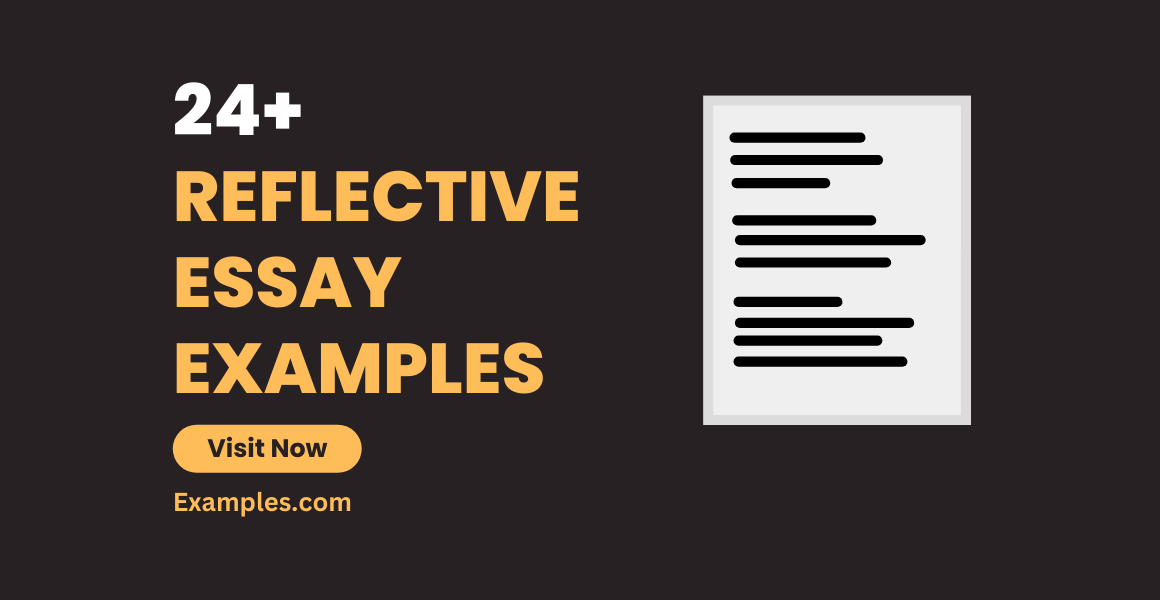
Sometimes, it is our experiences that startled and challenged our own voyage that strengthens and improves us to be the best versions of ourselves. If your life experience greatly moved you, there is a certain essay that allows you to compose your own endeavor. In this article, read through because we will be discussing the fundamentals of writing a reflective essay.
They say that being wise is better than being knowledgeable. Wisdom is acquired through reflection of one’s experience as well as of the environment. The more we reflect the more we become aware of ourselves. We become mindful of our existence as well as the meaning of life and all the things that surround us. Here we present different formats of essays like essays in doc .
Reflective Essay Outline Template

- Google Docs
Size: 188 KB
Reflective Essay About Life Experience
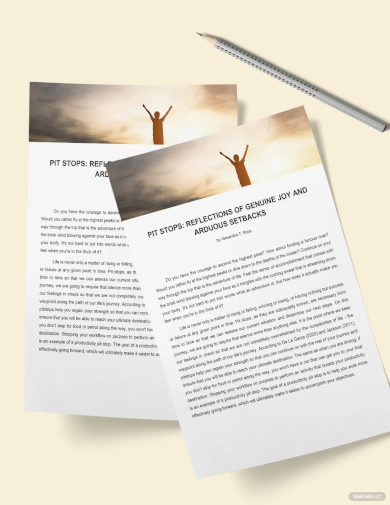
- Apple Pages
Size: 142 KB
Reflective Essay Template
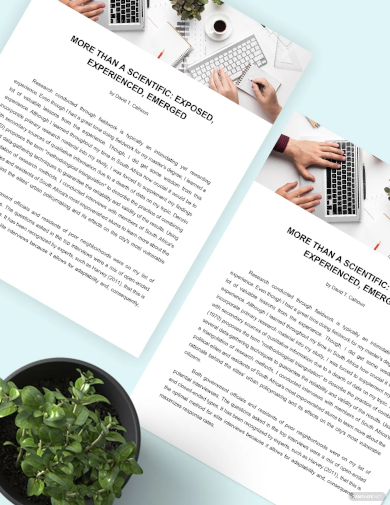
Size: 237 KB
Self Reflective Essay Template
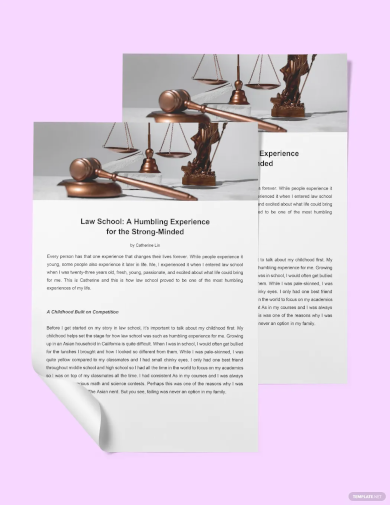
Size: 114 KB
Personal Reflective Essay Template
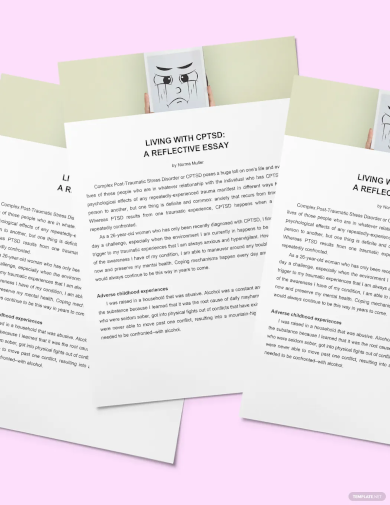
Size: 126 KB
Personal Reflective Sample
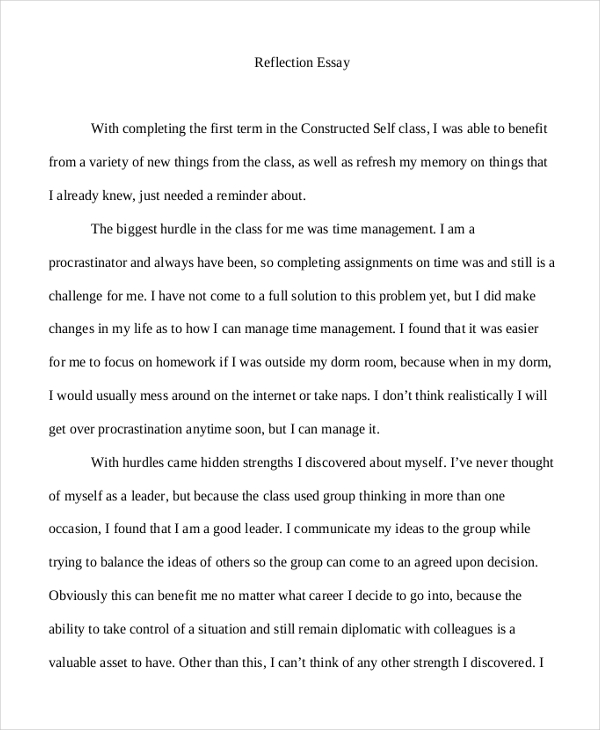
High School Essay

- PDFReflective Essay Example Reflective Essay Example Reflective Essay Example
Size: 102 KB
Reflective Essay Outline
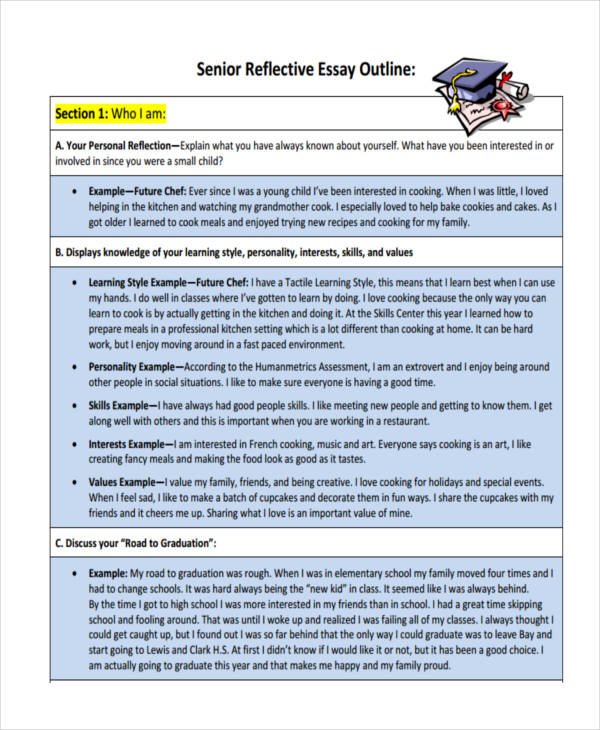
Size: 247 KB
Student Reflective Example
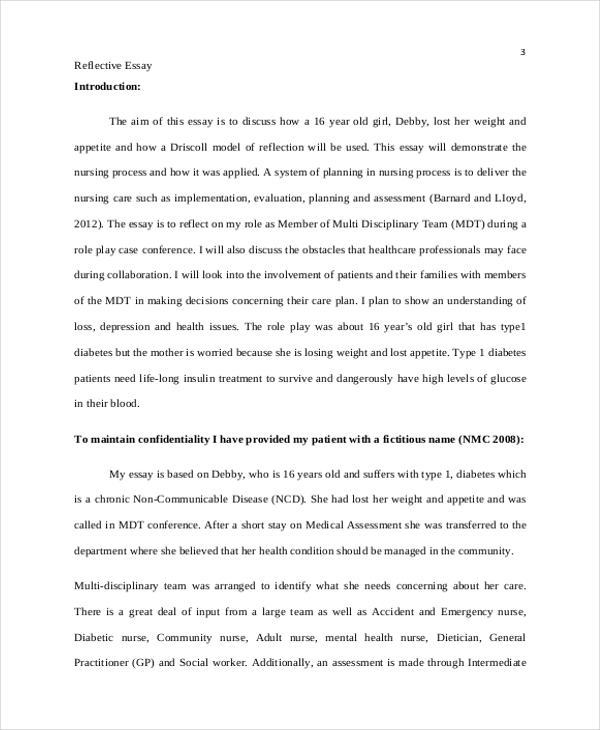
Size: 42 KB
Communication Reflective
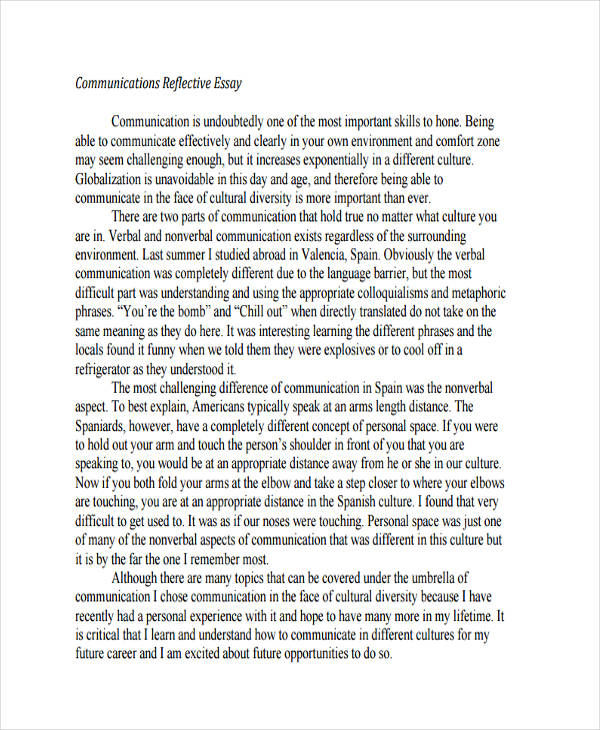
Size: 66 KB
What Is a Reflective Essay?
A reflective essay is a written piece of literature that focuses on presenting and narrating a person’s experience and how it becomes an instrument towards a change of perception in life.
It is a way for a writer to share an important event in his/her life and how it affected him/her so that others may learn something from it. Reflective writing root on life-changing events. The writer shares a specific experience, provides a narration of the incident including the material elements. It offers a realization so that others who may have had the same experience can draw out a shared mutual lesson from it.
How to Write a Reflective Essay
To write a reflective short essay , you need to have the right disposition as well as the momentum. Remember that you are not just writing to say something but to share an important lesson in life.
1. Think of an important event. What you will be writing on your reflective essay is something that is rooted in your own personal experience or encounter of something. Think deep and concentrate. You may also see personal essay examples & samples.
2. Introduce your topic. In your introduction, write the concrete event or experience that you want to share. Pattern it in a story form.
3. Develop your point. Write the main content of your essay with at least three to five paragraphs supporting your main topic.
Final Reflective Essay
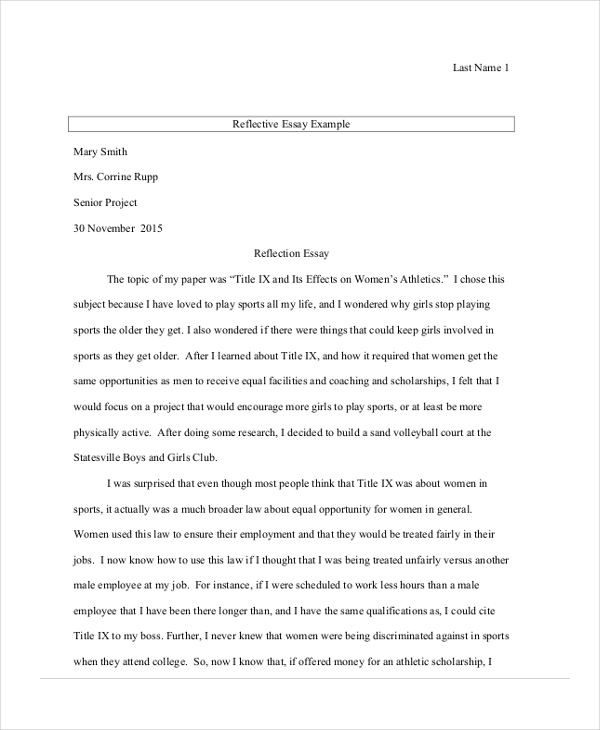
Size: 49 KB
Internship Reflective Essay
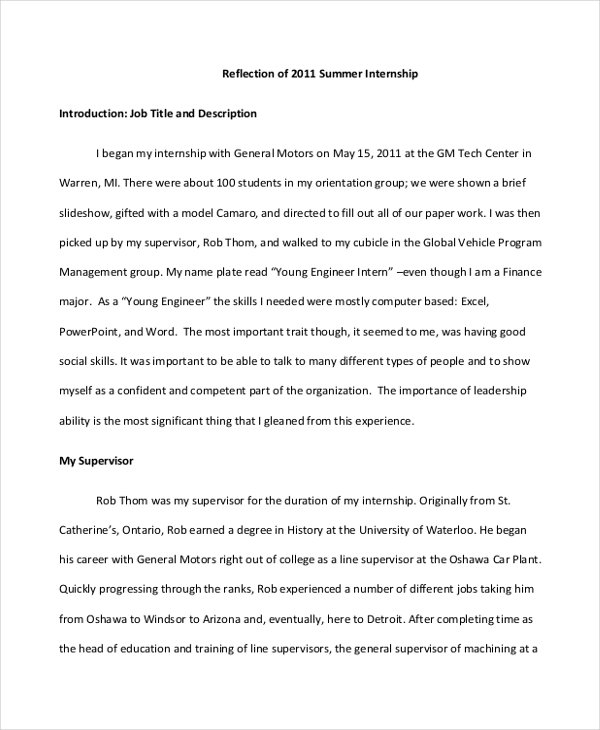
Size: 285 KB
Leadership Reflective Example
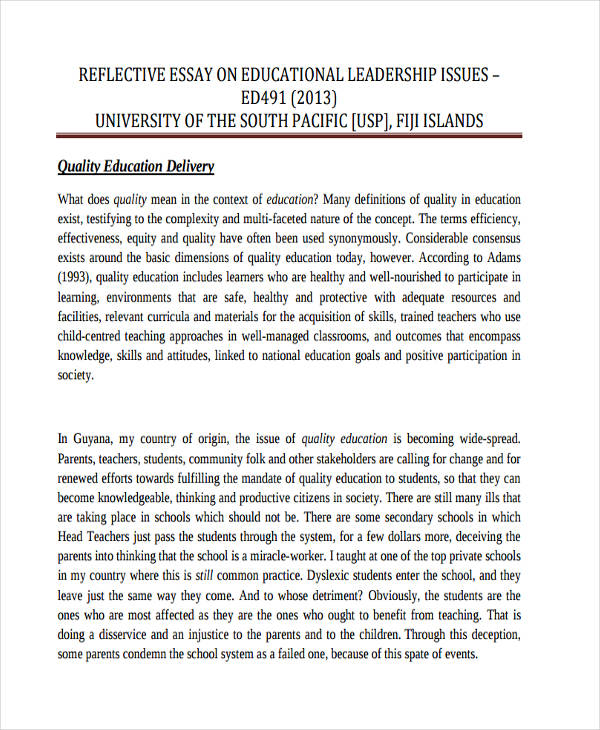
Size: 634 KB
Nursing Reflective Essay
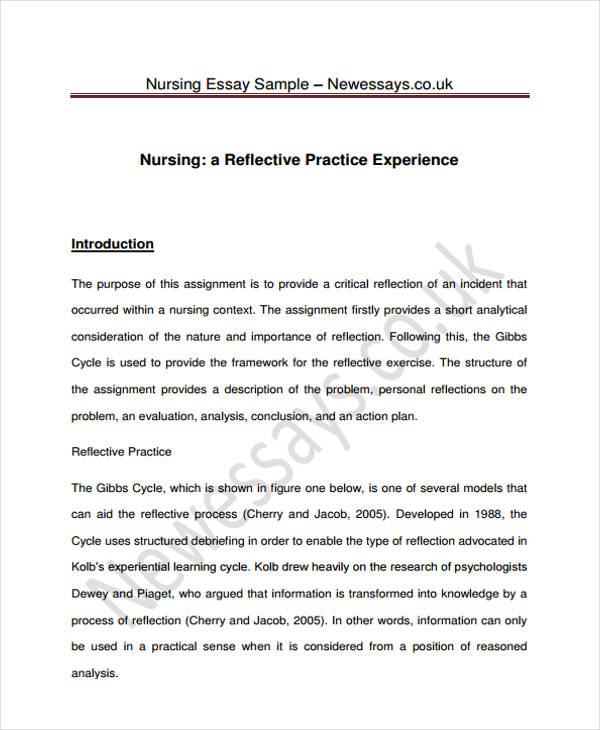
Size: 331 KB
Research Reflective Example
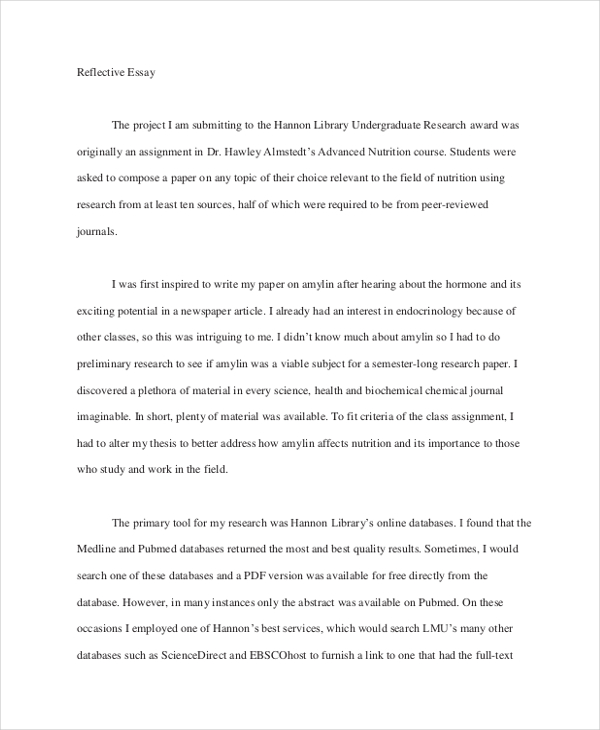
Size: 155 KB
Tips on Writing a Reflective Essay
Writing a reflective essay is not persuasive writing where you have to convince your readers to accept your opinion. You simply have to share an experience.
1. Write a draft. Do not jump hastily onto formal writing . Write a draft where you can create a bulleted list of the things that you want to share.
2. Think logically. When presenting a story, do it in a chronological manner so that your readers can understand the plot. Do this as well when presenting your ideas.
3. Create a summary. Use a summary writing to briefly state your insights and to give your final thoughts of the topic.
Importance of a Reflective Essay
In this era that we currently live in, personal reflection can be considered a thing of the past. Because of the gradual change and development of the things around us, we find it difficult to pause and reflect on the things that happen to our lives. You may also see academic essay examples .
The importance of writing an essay is to present to us the things that we rarely encounter in our day-to-day activities. In this time when material things are all that mattered, we have become unappreciative of the abstract things like love, compassion, and mercy. We cannot learn these things from those electronic gadgets that keep us busy.
How to Start a Reflective Essay Correctly
As mentioned above, a reflective essay presents and narrates the experience of a writer and how it changes the way he/she perceives life. In a simpler sense, it talks about how the author reflected on a certain adventure. As an essayist, since it’s you who bears the story and lessons, you are the one who is responsible for expressing it.
Just like any other composition, it’s your introduction that catches the attention of the reader. Thus, in order for your essay to be fully read, it is important to start your essay remarkably. If you find writing an introduction for your reflective essay challenging, don’t worry, you’re not alone. In this section, we are going to slowly tackle the ways to compose a compelling introduction.
1. Being catchy is the key.
In writing your reflective essay, you must start with something that would captivate the readers right away. Since the purpose of the introduction is to grab some attention, you may include some unique and interesting facts or beliefs. In this part, showcase your creativity by adding an introduction that is written in a bizarre manner and not those that depict cliché experience. You may also utilize a highly moving quotation or a dialogue that would also be appropriate for your reader.
2. Write the thesis statement in one sentence.
A thesis statement refers to the sentence that carries the topic being discussed in the whole essay. Therefore, it bears the central idea in which your essay revolves around. In writing your own essay, construct this statement in a clear and concise sentence. In this way, the reader will have a better grasp of your topic and would be clearly oriented on what you want to convey. In most cases, thesis statements are written at the end of the introduction.
3. Stick to the first person POV.
Remembering that this essay is subjective and depends on the author’s interpretation, it is important to use the first person point of view. By using this POV, it would be easier for you to convey your thoughts and opinions, and it would engage you to the readers like you’re telling a story in person. The first person involves the pronouns I , me , my , and mine .
4. Keep it brief.
When it comes to writing your own essay, you must perceive what your readers feel or see in reading your composition. Always put into mind that readers also have their own time to spend, and without a mark in the writing industry, people won’t invest much time on reading your essay. Thus, it is important to keep your composition concise. You can utilize a paragraph of five to ten sentences in your introduction. Using this number of sentences, you must already express a complete and clear thought of an essay that is worth reading.
Reflective Essay Example
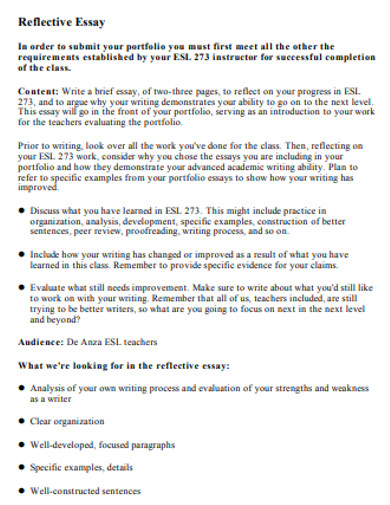
Size: 73 KB
Reflective Essay Assessment
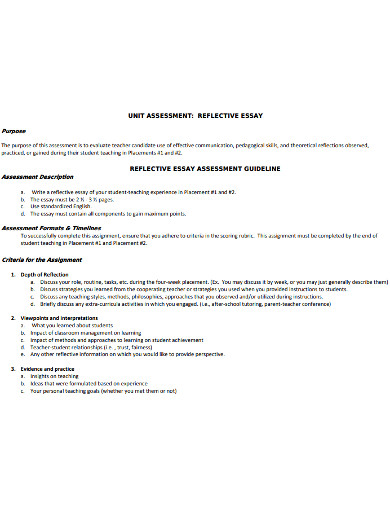
Size: 99 KB
Reflective Essay Format
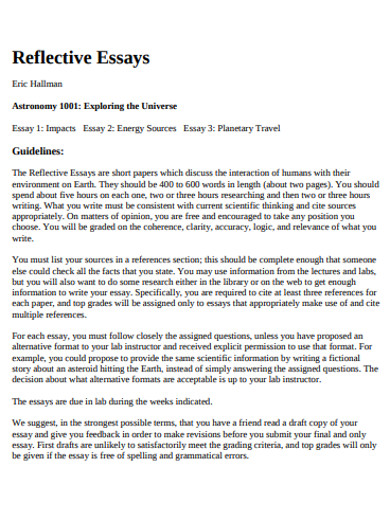
Size: 278 KB
Basic Reflective Essay
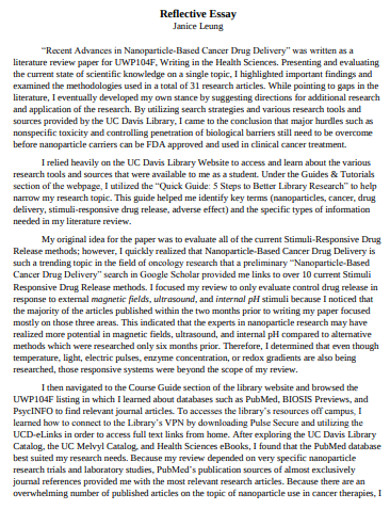
Size: 81 KB
Reflective Final Essay
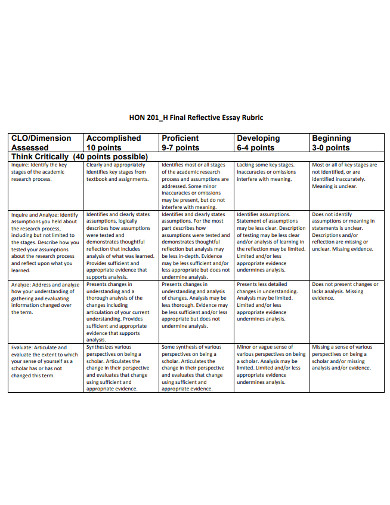
Size: 85 KB
Sample Reflective Essay
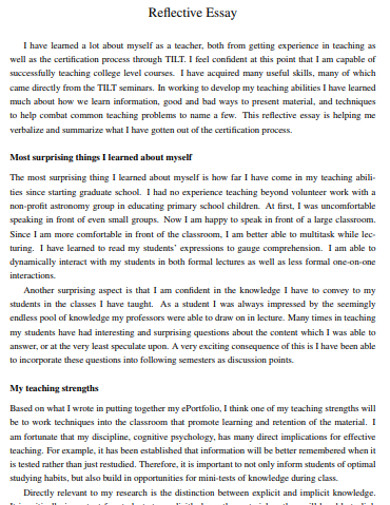
Size: 38 KB
Simple Reflective Essay Example
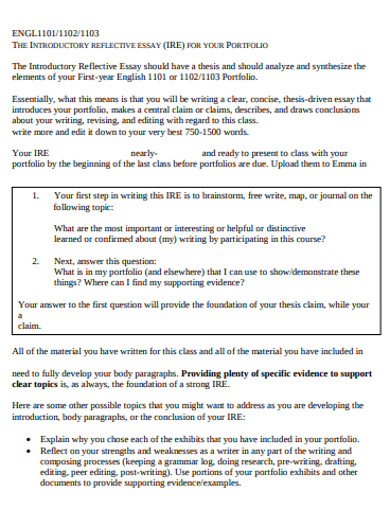
Size: 193 KB
Standard Reflective Essay
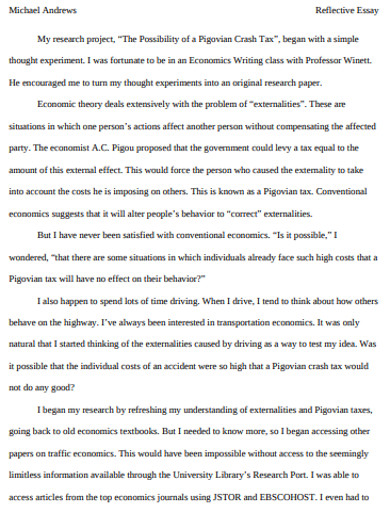
Professional Reflective Essay
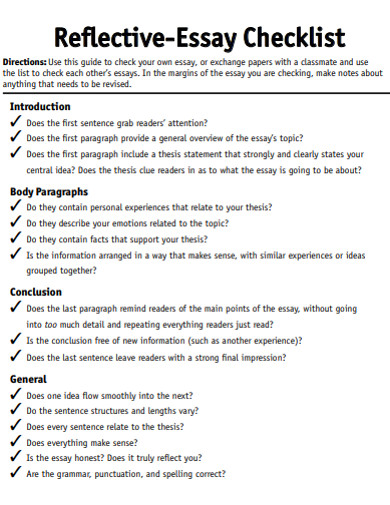
Size: 264 KB
Sample Reflective Essay in PDF
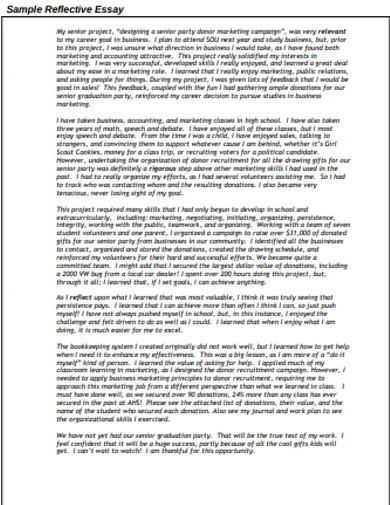
Size: 26 KB
Text prompt
- Instructive
- Professional
Write a Reflective Essay on your most meaningful learning experience.
Create a Reflective Essay about a time when you showed leadership.
'ZDNET Recommends': What exactly does it mean?
ZDNET's recommendations are based on many hours of testing, research, and comparison shopping. We gather data from the best available sources, including vendor and retailer listings as well as other relevant and independent reviews sites. And we pore over customer reviews to find out what matters to real people who already own and use the products and services we’re assessing.
When you click through from our site to a retailer and buy a product or service, we may earn affiliate commissions. This helps support our work, but does not affect what we cover or how, and it does not affect the price you pay. Neither ZDNET nor the author are compensated for these independent reviews. Indeed, we follow strict guidelines that ensure our editorial content is never influenced by advertisers.
ZDNET's editorial team writes on behalf of you, our reader. Our goal is to deliver the most accurate information and the most knowledgeable advice possible in order to help you make smarter buying decisions on tech gear and a wide array of products and services. Our editors thoroughly review and fact-check every article to ensure that our content meets the highest standards. If we have made an error or published misleading information, we will correct or clarify the article. If you see inaccuracies in our content, please report the mistake via this form .
What is ChatGPT and why does it matter? Here's what you need to know

What is ChatGPT?
ChatGPT is an AI chatbot with natural language processing (NLP) that allows you to have human-like conversations to complete various tasks. The generative AI tool can answer questions and assist you with tasks such as composing emails, essays, code, and more.
Also : How to use ChatGPT: What you need to know now
It's currently open to use for free . A paid subscription version called ChatGPT Plus launched in February 2023 with access to priority access to OpenAI's latest models and updates.
Who made ChatGPT?
AI startup OpenAI launched ChatGPT on November 30, 2022. OpenAI has also developed DALL-E 2 and DALL-E 3 , popular AI image generators , and Whisper, an automatic speech recognition system.
Who owns ChatGPT currently?
OpenAI owns ChatGPT. Microsoft is a major investor in OpenAI thanks to multiyear, multi-billion dollar investments. Elon Musk was an investor when OpenAI was first founded in 2015, but has since completely severed ties with the startup and created his own AI chatbot, Grok .
How can you access ChatGPT?
On April 1, 2024, OpenAI stopped requiring you to log in to use ChatGPT. Now, you can access ChatGPT simply by visiting chat.openai.com . You can also access ChatGPT via an app on your iPhone or Android device.
Once you visit the site, you can start chatting away with ChatGPT. A great way to get started is by asking a question, similar to what you would do with Google. You can ask as many questions as you'd like.
Also: ChatGPT no longer requires a login, but you might want one anyway. Here's why
There are still some perks to creating an OpenAI account, such saving and reviewing your chat history and accessing custom instructions. Creating an OpenAI account is entirely free and easy. You can even log in with your Google account.
For step-by-step instructions, check out ZDNET's guide on how to start using ChatGPT .
Is there a ChatGPT app?
Yes, an official ChatGPT app is available for both iPhone and Android users.
Also: ChatGPT dropped a free app for iPhones. Does it live up to the hype?
Make sure to download OpenAI's app, as there are a plethora of copycat fake apps listed on Apple's App Store and the Google Play Store that are not affiliated with the startup.
Is ChatGPT available for free?
ChatGPT is free to use, regardless of what you use it for, including writing, coding, and much more.
There is a subscription option , ChatGPT Plus, that users can take advantage of that costs $20/month. The paid subscription model guarantees users extra perks, such as priority access to GPT-4o and the latest upgrades.
Also: ChatGPT vs ChatGPT Plus: Is it worth the subscription fee?
Although the subscription price may seem steep, it is the same amount as Microsoft Copilot Pro and Google One AI, Microsoft's and Google's premium AI offerings.
The free version is still a solid option as it can access the same model and most of the same perks. One major exception: only subscribers get guaranteed access to GPT-4o when the model is at capacity.
I tried using ChatGPT and it says it's at capacity. What does that mean?
The ChatGPT website operates using servers. When too many people hop onto these servers, they may overload and can't process your request. If this happens to you, you can visit the site later when fewer people are trying to access the tool. You can also keep the tab open and refresh it periodically.
Also: The best AI chatbots
If you want to skip the wait and have reliable access, you can subscribe to ChatGPT Plus for general access during peak times, faster response times, and priority access to new features and improvements, including priority access to GPT-4o.
You can also try using Bing's AI chatbot, Copilot . This chatbot is free to use, runs on GPT-4, has no wait times, and can access the internet for more accurate information.
What is ChatGPT used for?
ChatGPT has many functions in addition to answering simple questions. ChatGPT can compose essays , have philosophical conversations, do math, and even code for you .
The tasks ChatGPT can help with also don't have to be so ambitious. For example, my favorite use of ChatGPT is for help creating basic lists for chores, such as packing and grocery shopping, and to-do lists that make my daily life more productive. The possibilities are endless.
ZDNET has published many ChatGPT how-to guides. Below are some of the most popular ones.
Use ChatGPT to:
- Write an essay
- Create an app
- Build your resume
- Write Excel formulas
- Summarize content
- Write a cover letter
- Start an Etsy business
- Create charts and tables
- Write Adruino drivers
Can ChatGPT generate images?
Yes, ChatGPT can generate images, but only for ChatGPT Plus subscribers. Since OpenAI discontinued DALL-E 2 in February 2024, the only way to access its most advanced AI image generator, DALL-E 3, through OpenAI's offerings is via its chatbot and ChatGPT Plus subscription.
Also: DALL-E adds new ways to edit and create AI-generated images. Learn how to use it
Microsoft's Copilot offers image generation, which is also powered by DALL-E 3, in its chatbot for free. This is a great alternative if you don't want to shell out the money for ChatGPT Plus.
How does ChatGPT work?
ChatGPT runs on a large language model (LLM) architecture created by OpenAI called the Generative Pre-trained Transformer (GPT). Since its launch, the free version of ChatGPT ran on a fine-tuned model in the GPT-3.5 series until May 2024, when the startup upgraded the model to GPT-4o.
Also: Here's a deep dive into how ChatGPT works
With a subscription to ChatGPT Plus , you can access GPT-3.5, GPT-4, or GPT-4o . Plus, users also have the added perk of priority access to GPT-4o, even when it is at capacity, while free users get booted down to GPT-3.5.
Generative AI models of this type are trained on vast amounts of information from the internet, including websites, books, news articles, and more.
What does ChatGPT stand for?
As mentioned above, the last three letters in ChatGPT's namesake stand for Generative Pre-trained Transformer (GPT), a family of large language models created by OpenAI that uses deep learning to generate human-like, conversational text.
Also: What does GPT stand for? Understanding GPT 3.5, GPT 4, GPT-4 Turbo, and more
The "Chat" part of the name is simply a callout to its chatting capabilities.
Is ChatGPT better than a search engine?
ChatGPT is a language model created to converse with the end user. A search engine indexes web pages on the internet to help users find information. One is not better than the other, as each suit different purposes.
When searching for as much up-to-date, accurate information as you can access, your best bet is a search engine. It will provide you with pages upon pages of sources you can peruse.
Also: The best AI search engines of 2024: Google, Perplexity, and more
As of May, the free version of ChatGPT can get responses from both the GPT-4o model and the web. It will only pull its answer from, and ultimately list, a handful of sources, as opposed to showing nearly endless search results.
For example, I used GPT-4o to answer, "What is the weather today in San Francisco?" The response told me it searched four sites and provided links to them.
If you are looking for a platform that can explain complex topics in an easy-to-understand manner, then ChatGPT might be what you want. If you want the best of both worlds, there are plenty of AI search engines on the market that combine both.
What are ChatGPT's limitations?
Despite its impressive capabilities, ChatGPT still has limitations. Users sometimes need to reword questions multiple times for ChatGPT to understand their intent. A bigger limitation is a lack of quality in responses, which can sometimes be plausible-sounding but are verbose or make no practical sense.
Instead of asking for clarification on ambiguous questions, the model guesses what your question means, which can lead to poor responses. Generative AI models are also subject to hallucinations, which can result in inaccurate responses.
Does ChatGPT give wrong answers?
As mentioned above, ChatGPT, like all language models, has limitations and can give nonsensical answers and incorrect information, so it's important to double-check the data it gives you.
Also: 8 ways to reduce ChatGPT hallucinations
OpenAI recommends that you provide feedback on what ChatGPT generates by using the thumbs-up and thumbs-down buttons to improve its underlying model. You can even join the startup's Bug Bounty program , which offers up to $20,000 for reporting security bugs and safety issues.
Can ChatGPT refuse to answer my prompts?
AI systems like ChatGPT can and do reject inappropriate requests . The AI assistant can identify inappropriate submissions to prevent the generation of unsafe content.
Also: 6 things ChatGPT can't do (and another 20 it refuses to do)
These submissions include questions that violate someone's rights, are offensive, are discriminatory, or involve illegal activities. The ChatGPT model can also challenge incorrect premises, answer follow-up questions, and even admit mistakes when you point them out.
These guardrails are important. AI models can generate advanced, realistic content that can be exploited by bad actors for harm, such as spreading misinformation about public figures and influencing elections .
Can I chat with ChatGPT?
Although some people use ChatGPT for elaborate functions, such as writing code or even malware , you can use ChatGPT for more mundane activities, such as having a friendly conversation.
Also: Do you like asking ChatGPT questions? You could get paid (a lot) for it
Some conversation starters could be as simple as, "I am hungry, what food should I get?" or as elaborate as, "What do you think happens in the afterlife?" Either way, ChatGPT is sure to have an answer for you.
Is ChatGPT safe?
People are expressing concerns about AI chatbots replacing or atrophying human intelligence. For example, a chatbot can write an article on any topic efficiently (though not necessarily accurately) within seconds, potentially eliminating the need for human writers.
Chatbots can also write an entire essay within seconds, making it easier for students to cheat or avoid learning how to write properly. This even led some school districts to block access when ChatGPT initially launched.
Also: Generative AI can be the academic assistant an underserved student needs
Now, not only have many of those schools decided to unblock the technology, but some higher education institutions have been catering their academic offerings to AI-related coursework.
Another concern with AI chatbots is the possible spread of misinformation. ChatGPT itself says: "My responses are not intended to be taken as fact, and I always encourage people to verify any information they receive from me or any other source." OpenAI also notes that ChatGPT sometimes writes "plausible-sounding but incorrect or nonsensical answers."
Also: Microsoft and OpenAI detect and disrupt nation-state cyber threats that use AI, report shows
Lastly, there are ethical concerns regarding the information ChatGPT was trained on, since the startup scraped the internet to train the chatbot.
It also automatically uses people's interactions with the free version of the chatbot to further train its models, raising privacy concerns. OpenAI lets you turn off training in ChatGPT's settings.
Does ChatGPT plagiarize?
Yes, sort of. OpenAI scraped the internet to train ChatGPT. Therefore, the technology's knowledge is influenced by other people's work. Since there is no guarantee that when OpenAI outputs its answers it is entirely original, the chatbot may regurgitate someone else's work in your answer, which is considered plagiarism.
Is there a ChatGPT detector?
Concerns about students using AI to cheat mean the need for a ChatGPT text detector is becoming more evident.
In January 2023, OpenAI released a free tool to target this problem. Unfortunately, OpenAI's "classifier" tool could only correctly identify 26% of AI-written text with a "likely AI-written" designation. Furthermore, it provided false positives 9% of the time, incorrectly identifying human-written work as AI-produced.
The tool performed so poorly that, six months after being released, OpenAI it shut down "due to its low rate of accuracy." Despite the tool's failure, the startup claims to be researching more effective techniques for AI text identification.
Also: OpenAI unveils text-to-video model and the results are astonishing
Other AI detectors exist on the market, including GPT-2 Output Detector , Writer AI Content Detector , and Content at Scale's AI Content Detection tool. ZDNET put these tools to the test, and the results were underwhelming: all three were found to be unreliable sources for spotting AI, repeatedly giving false negatives. Here are ZDNET's full test results .
What are the common signs something was written by ChatGPT?
Although tools aren't sufficient for detecting ChatGPT-generated writing, a study shows that humans could detect AI-written text by looking for politeness. The study's results indicate that ChatGPT's writing style is extremely polite . And unlike humans, it cannot produce responses that include metaphors, irony, or sarcasm.
Will my conversations with ChatGPT be used for training?
One of the major risks when using generative AI models is that they become more intelligent by being trained on user inputs. Therefore, when familiarizing yourself with how to use ChatGPT, you might wonder if your specific conversations will be used for training and, if so, who can view your chats.
Also: This ChatGPT update fixed one of my biggest productivity issues with the AI chatbot
OpenAI will use your conversations with the free chatbot to automatically training data to refine its models. You can opt out of the startup using your data for model training by clicking on the question mark in the bottom left-hand corner, Settings, and turning off "Improve the model for everyone."
What is GPT-4?
GPT-4 is OpenAI's language model that is much more advanced than its predecessor, GPT-3.5. Users can access GPT-4 by subscribing to ChatGPT Plus for $20 per month or using Microsoft's Copilot.
Also: What does GPT stand for? Understanding GPT-3.5, GPT-4, and more
GPT-4 has advanced intellectual capabilities, meaning it outperforms GPT-3.5 in a series of simulated benchmark exams. The newer model also supposedly produces fewer hallucinations.
What is GPT-4o?
GPT-4o is OpenAI's latest, fastest, and most advanced flagship model. As the name implies, it has the same intelligence as GPT-4. However, the "o" in the title stands for "omni," referring to its multimodal capabilities, which allow it to understand text, audio, image, and video inputs and output text, audio, and image outputs.
Also: 6 ways OpenAI just supercharged ChatGPT for free users
The model is 50% cheaper in the API than GPT-4 Turbo while still matching its English and coding capabilities and outperforming it in non-English languages, vision, and audio understanding -- a big win for developers.
Are there alternatives to ChatGPT worth considering?
Although ChatGPT gets the most buzz, other options are just as good -- and might even be better suited to your needs. ZDNET has created a list of the best chatbots, which have all been tested by us and show which tool is best for your requirements.
Also: 4 things Claude AI can do that ChatGPT can't
Despite ChatGPT's extensive abilities, there are major downsides to the AI chatbot. If you want to try the technology, there are plenty of other options: Copilot , Claude , Perplexity , Jasper , and more.
Is ChatGPT smart enough to pass benchmark exams?
Yes, ChatGPT is capable of passing a series of benchmark exams. A professor at Wharton, the University of Pennsylvania's business school, used ChatGPT to take an MBA exam and the results were quite impressive.
ChatGPT not only passed the exam, but the tool scored between a B- and a B. The professor, Christian Terwiesch, was impressed at its basic operations management, process analysis questions, and explanations.
OpenAI also tested the chatbot's ability to pass benchmark exams. Although ChatGPT could pass many of these benchmark exams, its scores were usually in the lower percentile. However, with GPT-4, ChatGPT can score much higher.
For example, ChatGPT using GPT-3.5 scored in the lower 10th percentile of a simulated Bar Exam, while GPT-4 scored in the top 10th percentile. You can see more examples from OpenAI in the chart below.
Can ChatGPT be used for job application assistance?
Yes, ChatGPT is a great resource to help with job applications. Undertaking a job search can be tedious and difficult, and ChatGPT can help you lighten the load. ChatGPT can build your resume and write a cover letter .
Also : How to use ChatGPT to write an essay
If your application has any written supplements, you can use ChatGPT to help you write those essays or personal statements .
What are the most common ChatGPT plugins, and how do I use them?
Plugins allowed ChatGPT to connect to third-party applications, including access to real-time information on the web. The plugins expanded ChatGPT's abilities , allowing it to assist with many more activities, such as planning a trip or finding a place to eat.
Also: My two favorite ChatGPT Plus features and the remarkable things I can do with them
On March 19, 2024, however, OpenAI stopped allowing users to install new plugins or start new conversations with existing ones. Instead, OpenAI replaced plugins with GPTs , which are easier for developers to build.
Users can find 3 million ChatGPT chatbots, also known as GPTs, on the GPT store. Unfortunately, there is also a lot of spam in the GPT store.
What is Microsoft's involvement with ChatGPT?
Microsoft was an early investor in OpenAI, the AI startup behind ChatGPT, long before ChatGPT was released to the public. Microsoft's first involvement with OpenAI was in 2019, when the company invested $1 billion, and then another $2 billion in the years after. In January 2023, Microsoft extended its partnership with OpenAI through a multiyear, multi-billion dollar investment .
Also: ChatGPT vs. Copilot: Which AI chatbot is better for you?
Neither company disclosed the investment value, but unnamed sources told Bloomberg that it could total $10 billion over multiple years. In return, OpenAI's exclusive cloud-computing provider is Microsoft Azure, powering all OpenAI workloads across research, products, and API services.
Microsoft has also used its OpenAI partnership to revamp its Bing search engine and improve its browser.
On February 7, 2023, Microsoft unveiled a new Bing tool , now known as Copilot, that runs on OpenAI's GPT-4, customized specifically for search.
What does Copilot (formerly Bing Chat) have to do with ChatGPT?
In February 2023, Microsoft unveiled a new version of Bing -- and its standout feature was its integration with ChatGPT. When it was announced, Microsoft shared that Bing Chat, now Copilot, was powered by a next-generation version of OpenAI's large language model, making it "more powerful than ChatGPT." Five weeks after the launch, Microsoft revealed that Copilot had been running on GPT-4 before the model had even launched.
How does Copilot compare to ChatGPT?
Copilot uses OpenAI's GPT-4, which means that since its launch, it has been more efficient and capable than the standard, free version of ChatGPT. At the time, Copilot boasted several other features over ChatGPT, such as access to the internet, knowledge of current information, and footnotes.
In May 2024, however, OpenAI supercharged the free version of its chatbot with GPT-4o. The upgrade gave users GPT-4 level intelligence, the ability to get responses from the web via ChatGPT Browse with Bing, analyze data, chat about photos and documents, use GPTs, access the GPT Store, and Voice Mode. Therefore, after the upgrade, ChatGPT reclaimed its crown as the best AI chatbot.
What is Gemini and how does it relate to ChatGPT?
Gemini is Google's AI chat service, a rival to ChatGPT. On February 6, 2023, Google introduced its experimental AI chat service, which was then called Google Bard. Over a month after the announcement, Google began rolling out access to Bard first via a waitlist . Now, it is available to the general public.
Artificial Intelligence
Chatgpt vs. copilot: which ai chatbot is better for you, how to use chatgpt (and how to access gpt-4o), what does gpt stand for understanding gpt-3.5, gpt-4, gpt-4o, and more.

Northwest Expedition Academy students explore support dog work through writing
Lucy, a forensic interview and courtroom support dog, works at the Safe Passage Children's Advocacy Center. Press File
Lucy, a forensic interview and courtroom support dog, works at the Safe Passage Children's Advocacy Center.
Northwest Expedition Academy fourth graders spent two months this spring learning all about support dogs, including local dogs Lucy, Rocket and Murphy. The students also made their own art of the canines, pictured here.
Fourth graders at Northwest Expedition Academy spent time this spring investigating the question, "How do support dogs make a difference in people’s lives?"
Four different support dogs from the community came into the classroom so students could learn more about their specific jobs. Students spent time researching each dog’s specialized senses that make them so adept for support work.
Below are op-ed pieces written by the students. More essays will be published in Friday's Press.
Lucy the therapy dog By KIARRA GAYMAN
Imagine you are a kid and something frightening happened to you and you had to talk about it with someone that you barely know.
Wouldn't you feel better with a dog by your side?
Some people think that the dogs don't help or they would rather not have one to help comfort them. Other people think they help them open up easier and they would have less anxiety talking about it. Lucy is a therapy dog that helps kids who have trauma feel better while they are talking to her owner Scott Coleman about the incident that happened to them. Lucy makes the biggest difference in people's lives because she helps calm you down if you have stress or anxiety, she can smell if you are stressed and will help you and she will snuggle you for hours if you need it.
Lucy makes the biggest difference in people’s lives because she helps calm them down. Lucy’s owner says, “She helps with kids when something happens to them to help the kids have less stress.” This is important because if you did not have Lucy, think about how much more stress you would have.
Secondly, Lucy is important because she can smell when you are stressed. If you have stress your dog can sense it and help stop a potential panic attack. Therefore, Lucy can smell if your stress and help you.
Lastly, Lucy makes the biggest difference in people’s lives because she will snuggle you for hours if you need it. Her owner said, “Lucy’s favorite activity is snuggling and she will do it for hours on end.” This is important because it can make you feel better while talking to her owner and she can sit on your lap and comfort you.
When you see a dog that has a vest on in public, that usually means they are working and cannot be disrupted. Sometimes people see therapy dogs and pet them, that is not OK. When therapy dogs get disrupted that means they cannot do their jobs, which could lead to something happening to the owner. Please do not touch a therapy dog in public, or even talk to it because that could also distract the dog.
Rocket the therapy dog By JONAH KING
Imagine you are in the police station. You are having a terrible day.
A trained therapy dog walks through the door. He is white with brown spots and has cute little floppy ears. His breed is a Brittany. The owner lets you pet him.
This is Rocket. You suddenly feel much better. Rocket works for the Kootenai County Sheriff's Office. Rocket makes the biggest difference in policemen's lives because he helps elevate their mood, he helps them feel calm and he helps policemen socialize.
Rocket helps elevate policemen’s moods. I think this because his owner, John McSwain, was a previous presenter for fourth grade on their project-based learning. He is a retired policeman, a therapy dog trainer and still works for the police department.
“Rocket is nonjudgmental," he said.
I think this is a good thing to help elevate policemen’s moods. This is important because if policemen are not happy it would be a world of sadness. They would quit their job, make no money and not survive. This way without policemen no one would be safe. Therefore, Rocket helps elevate policemen’s moods.
Secondly, Rocket helps policemen feel calm. I think this because Mr. John said, “Whenever policemen pet Rocket, they let go of all of their anxiety because the softness of his fur helps with emotional problems.” This is important because then people are not stressed all of the time.
Rocket helps policemen socialize. I think this because Alliance of therapy dogs Inc. says, “Therapy dogs provide a more comfortable approach interacting with many individuals who are lonely and struggle to socialize.” In this case the “individuals” are policemen. This is important because if you do not have many friends it may cause mental distress, boredom, anxiety, depression and more.
In conclusion, Rocket makes the biggest difference in policemen’s lives because he helps elevate policemen's moods, he helps policemen feel calm and he helps policemen socialize. Now you can donate to Rocket by giving money to the Kootenai County Sheriff's Office.
Murphy By LIAM EVANDER RAVSTEN
Do you know a service dog like Murphy?
Murphy is an Urban Search And Rescue dog. Murphy makes the biggest difference in people's lives because he helps tell people when they are sick and he can help first responders calm down.
USAR dogs save people all over the world all the time. I know this from handler Cody Moore because he told me Murphy can smell people in hard-to-find places and save them. Dogs can also find people quicker than technology and humans. Dogs' noses are super strong. Dogs' noses are so powerful they can smell the past, present and future. This is important because people get trapped in weird places all the time and dogs can smell a scent trail to where they are. Therefore, USAR dogs are the best type of service dogs.
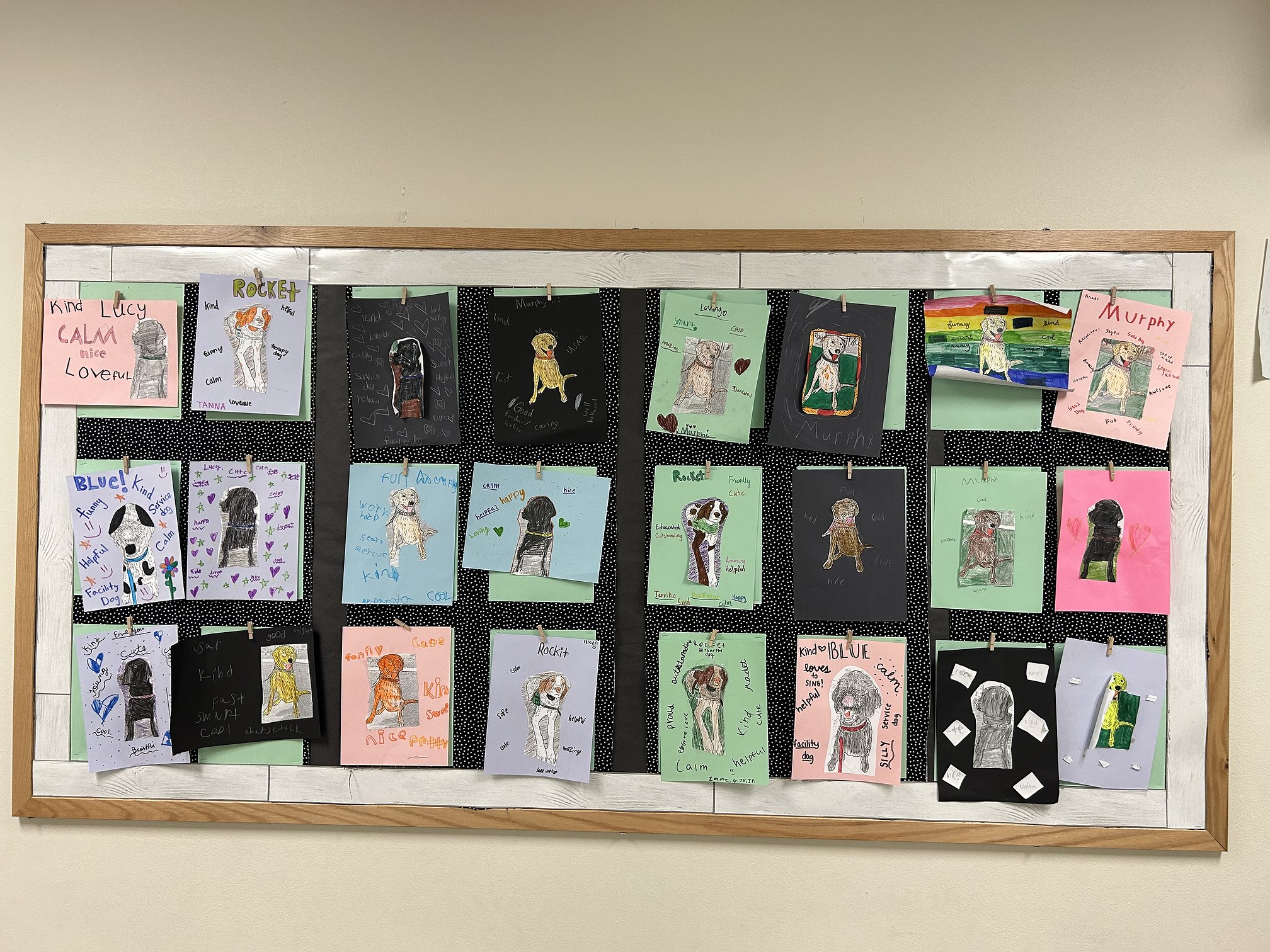
Share This Story

IMAGES
VIDEO
COMMENTS
We've compiled our best resources so you can take your writing skills to the next level. Your ideas are on the money. Make sure they come across clearly with Grammarly.
Get Instant Plagiarism Analysis. Write Clear, Compelling Papers And Essays With Justdone. Safeassign: Fast, Reliable & User-friendly. Perfect For Students & Professionals
The essay writing process consists of three main stages: Preparation: Decide on your topic, do your research, and create an essay outline. Writing: Set out your argument in the introduction, develop it with evidence in the main body, and wrap it up with a conclusion. Revision: Check your essay on the content, organization, grammar, spelling ...
Harvard College Writing Center 5 Asking Analytical Questions When you write an essay for a course you are taking, you are being asked not only to create a product (the essay) but, more importantly, to go through a process of thinking more deeply about a question or problem related to the course. By writing about a
The basic structure of an essay always consists of an introduction, a body, and a conclusion. But for many students, the most difficult part of structuring an essay is deciding how to organize information within the body. This article provides useful templates and tips to help you outline your essay, make decisions about your structure, and ...
An essay is a focused piece of writing that explains, argues, describes, or narrates. In high school, you may have to write many different types of essays to develop your writing skills. Academic essays at college level are usually argumentative : you develop a clear thesis about your topic and make a case for your position using evidence ...
The basic steps for how to write an essay are: Generate ideas and pick a type of essay to write. Outline your essay paragraph by paragraph. Write a rough first draft without worrying about details like word choice or grammar. Edit your rough draft, and revise and fix the details. Review your essay for typos, mistakes, and any other problems.
There are three main stages to writing an essay: preparation, writing and revision. In just 4 minutes, this video will walk you through each stage of an acad...
How to Find Essay Writing Inspiration. If you have essays to write but are short on ideas, this section's links to prompts, example student essays, and celebrated essays by professional writers might help. You'll find writing prompts from a variety of sources, student essays to inspire you, and a number of essay writing collections.
Tips for Reading an Assignment Prompt. Asking Analytical Questions. Thesis. Introductions. What Do Introductions Across the Disciplines Have in Common? Anatomy of a Body Paragraph. Transitions. Tips for Organizing Your Essay. Counterargument.
In general, your introductions should contain the following elements: When you're writing an essay, it's helpful to think about what your reader needs to know in order to follow your argument. Your introduction should include enough information so that readers can understand the context for your thesis. For example, if you are analyzing ...
Basic essay structure: the 3 main parts of an essay. Almost every single essay that's ever been written follows the same basic structure: Introduction. Body paragraphs. Conclusion. This structure has stood the test of time for one simple reason: It works. It clearly presents the writer's position, supports that position with relevant ...
An essay is a written composition that presents and supports a particular idea, argument, or point of view. It's a way to express your thoughts, share information, and persuade others to see things from your perspective. Essays come in various forms, such as argumentative, persuasive, expository, and descriptive, each serving a unique purpose.
Sample College Essay 2 with Feedback. This content is licensed by Khan Academy and is available for free at www.khanacademy.org. College essays are an important part of your college application and give you the chance to show colleges and universities your personality. This guide will give you tips on how to write an effective college essay.
Essay writing is an essential skill for every student. Whether writing a particular academic essay (such as persuasive, narrative, descriptive, or expository) or a timed exam essay, the key to getting good at writing is to write.
Here are the eight steps to write an essay: Stage 1: Planning. 1. Pick an appropriate research topic. In certain cases, your teacher or professor may assign you a topic. However, in many cases, students have the freedom to select a topic of their choice.
Here are the key takeaways for how to write essay introduction: 3. Hook the Reader: Start with an engaging hook to grab the reader's attention. This could be a compelling question, a surprising fact, a relevant quote, or an anecdote. Provide Background: Give a brief overview of the topic, setting the context and stage for the discussion.
Restate your thesis: remind readers of your main point. Reiterate your supporting points: remind readers of your evidence or arguments. Wrap everything up by tying it all together. Write a clincher: with the last sentence, leave your reader with something to think about. For many, the conclusion is the most dreaded part of essay writing.
Making an all-state team → outstanding achievement. Making an all-state team → counting the cost of saying "no" to other interests. Making a friend out of an enemy → finding common ground, forgiveness. Making a friend out of an enemy → confront toxic thinking and behavior in yourself.
A PDF providing further guidance on writing science essays for tutorials is available to download.. Short videos to support your essay writing skills. There are many other resources at Oxford that can help support your essay writing skills and if you are short on time, the Oxford Study Skills Centre has produced a number of short (2-minute) videos covering different aspects of essay writing ...
The writer of the academic essay aims to persuade readers of an idea based on evidence. The beginning of the essay is a crucial first step in this process. In order to engage readers and establish your authority, the beginning of your essay has to accomplish certain business. Your beginning should introduce the essay, focus it, and orient ...
Using evidence. Evidence is the foundation of an effective essay and provides proof for your points. For an essay about a piece of literature, the best evidence will come from the text itself ...
The writing process: brainstorm, outline, and draft . Writing a college essay can seem daunting at first, but it doesn't have to be. Watch our webinar, Write a College Essay that Stands Out, and download our worksheet as a template and foundation to help you craft a strong college essay. This college essay format may help you write your essay ...
Today's article focuses on my carefully crafted 10-step strategy for writing the perfect college application essay. With some colleges no longer considering factors like high school grades and standardized test scores (i.e., SAT and ACT scores ), the pressure to create a college application essay can be fierce but stress no more.
Apply the Right Evidence. Using relevant evidence is one of the best essay writing strategies. But simply dropping a quote won't cut it. The real magic comes from analyzing and integrating ...
In writing your own essay, construct this statement in a clear and concise sentence. In this way, the reader will have a better grasp of your topic and would be clearly oriented on what you want to convey. In most cases, thesis statements are written at the end of the introduction. 3. Stick to the first person POV.
Table of contents. Step 1: Hook your reader. Step 2: Give background information. Step 3: Present your thesis statement. Step 4: Map your essay's structure. Step 5: Check and revise. More examples of essay introductions. Other interesting articles. Frequently asked questions about the essay introduction.
Essays come in various forms, each demanding a unique approach and skill set. Among these, the reflective essay stands out as a beacon of introspection and self-expression. ... How to Write a Reflective Essay. To bring this fusion of narrative and analysis to life, you should consider the following key elements: Prepare the Canvas: Start by ...
Anger is growing in India after a teenager who allegedly killed two people while drunk driving was ordered to write an essay as punishment, with many demanding a harsher penalty and accusing the ...
Chatbots can also write an entire essay within seconds, making it easier for students to cheat or avoid learning how to write properly. This even led some school districts to block access when ...
Step 1: Return to your thesis. To begin your conclusion, signal that the essay is coming to an end by returning to your overall argument. Don't just repeat your thesis statement —instead, try to rephrase your argument in a way that shows how it has been developed since the introduction. Example: Returning to the thesis.
More essays will be published in Friday's Press. Lucy the therapy dog By KIARRA GAYMAN Imagine you are a kid and something frightening happened to you and you had to talk about it with someone ...